#why has hollywood become a recycling machine
Text
I think the problem with live action adaptations is that we really don't want them.
People are looking for every way to hate these shows and movies because we love the originals so much. We're starved for new, original content that's genuine and not just a cash grab.
Stop dragging past material back for alright to mediocre stuff that really doesn't do anything new. Give us NEW SHIT. Have these big production companies forgotten how to like... make up a story?
The LA avatar is ok. Just ok, where the original was fenominal. It has the same story beats, but just feels kinda hollow. PJO had a lot of the same issues.
Also Percy Jackson should have been a 2D animated series I mean COME ON. Animation has been valued less and less lately and it's just really sad.
The only exception to my ranting is the One Piece LA those guys somehow did it SO right. I never thought I'd love a live action remake before that.
#live action atla#atla live action#percy jackson and the olympians#percy jackson live action#one piece live action#I don't usually rant like this but capitalism is killing creativity and I need to talk about#where is the JOY AND WHIMSY#where are the NEW ideas#why has hollywood become a recycling machine#live action adaptations
68 notes
·
View notes
Text
Godzilla vs. Kong: A Brief History of Mechagodzilla
https://ift.tt/3sB2eYO
this article contains spoilers for godzilla vs. kong.
It may not have quite the cache or iconic status of Mothra or King Ghidorah, but Mechagodzilla has managed to become a consistent element in the Godzilla movie universe for years. And now the metallic wonder makes its Hollywood debut (not counting Ready Player One) in director Adam Wingard’s Godzilla vs. Kong, the fourth film in the modern MonsterVerse that kicked off in 2014 with Gareth Edwards’ Godzilla.
Ever since making its first appearance in 1974’s Godzilla vs. Mechagodzilla, the gigantic robotic reptile has stuck around as a relatively constant thorn in the side of his flesh-and-blood counterpart. If Ghidorah, Rodan, and Mothra are the Joker, Penguin, and Catwoman to Godzilla’s Batman, then Mechagodzilla hovers near the top of the second tier of rogues, the equivalent to a Two-Face or Mr. Freeze.
Mechagodzilla’s first appearance some 47 years ago came during the Showa era of the original Toho Studios series of Godzilla films. It was the result of some creative brainstorming following two absolutely terrible entries in the series, Godzilla vs. Gigan (1972) and Godzilla vs. Megalon (1973), which featured two of the big lizard’s more uninspiring enemies–a cyborg with a buzzsaw in its stomach and an oversized beetle, respectively.
Faced with the task of freshening up the Godzilla movies via some better antagonists, Toho execs were intrigued by the success of the robot anime genre in Japan at the time, and also wanted to recycle the idea of Mechani-Kong, the android Kong seen in the animated 1966 series The King Kong Show and the largely disastrous 1967 film, King Kong Escapes. Between Mechani-Kong, Gigan, and the robot Jet Jaguar, mechanical monsters already had a presence in Toho’s kaiju films, paving the way for Mechagodzilla.
Toho
Mechagodzilla in the Showa era
In Godzilla vs. Mechagodzilla, the title villain is the creation of alien invaders from the “Third Planet of the Black Hole,” who plan to use the robot to conquer Earth. Mechagodzilla’s initial rampage–in which it’s actually disguised as Godzilla–sets it against veteran Godzilla ally Anguirus, before Godzilla himself gets involved and goes head to head with the robot. A third monster–the massive protector deity King Caesar, also making his screen debut–gets involved in the action as well, helping the big G defeat his metallic counterpart in a rousing finale.
Godzilla vs. Mechagodzilla, which didn’t arrive in the U.S. until 1977, under the name Godzilla vs. the Bionic Monster, earned somewhat more at the box office than Godzilla vs. Megalon, even though the franchise was well past its glory days. Critics were a little kinder to the movie too, although not that much: Monthly Film Bulletin pointed out that it could have been “much less shambling than it was.”
Nevertheless, Toho tried again the following year with Terror of Mechagodzilla, the 15th film in the Godzilla series and the last of the initial Showa era. Even though it marked the return of director Ishiro Honda, who had helmed some of the franchise’s biggest classics, Terror ended up becoming (relative to inflation) the lowest grossing entry of all the Godzilla films–a distinction it sadly holds to this day.
The story followed a plot hatched by a mad scientist and the same aliens from the previous film to rebuild Mechagodzilla and team it up with a new monster called Titanosaurus in the hope of defeating Godzilla and wiping out humankind, but our fire-breathing hero and his human allies eventually smack that scheme down.
Interestingly, the screenplay for Terror of Mechagodzilla was written by Yukiko Takayama, who won a contest to provide Toho with an original story for its next Godzilla movie. Takayama’s initial concept for Titanosaurus was a pair of creatures called Titans–which is, of course, the overall name given to the giant creatures that now inhabit the MonsterVerse movies, including in Godzilla vs. Kong. The Titans in Terror were combined into one monster due to budget concerns.
Two Titans, or one lonely Titanosaurus, it didn’t matter much, because the financial struggle of Terror led to Toho ending the Showa era and putting the entire Godzilla franchise on ice for nearly 10 years. But while the big G re-emerged in 1984 with The Return of Godzilla (a.k.a. Godzilla 1985), it would be another nine years until a shiny new version of his mechanical opponent turned up in the Heisei era.
Toho
A new Mechagodzilla for the Heisei era
1993 brought Godzilla vs. Mechagodzilla II, the 20th film in the franchise and, strangely enough, not a sequel to the 1974 film of the same name. This time out, the United Nations’ military anti-Godzilla unit, G-Force, uses the remains of Mecha-King Ghidorah from the previous film, Godzilla vs. King Ghidorah, to create two machines capable of battling Godzilla: a weaponized aircraft called Garuda and a robot named–you guessed it–Mechagodzilla.
G-Force also has another advantage: it’s in possession of a new Baby Godzilla and uses the infant’s cries to lure Godzilla into battle with Mechagodzilla and Garuda. The latter two ultimately merge into something called Super-Mechagodzilla, and just when it looks like the big green guy is on the ropes, Rodan (who had been nearly killed by the machines earlier in the movie) shows up for a late assist.
Read more
Movies
Godzilla: First 15 Showa Era Movies Ranked
By Don Kaye
Movies
From Skull Island to Godzilla vs. Kong: A Complete MonsterVerse Timeline
By David Crow
As with the other films of the Heisei era, Godzilla vs. Mechagodzilla II benefits from a more serious approach and better special effects than were available in the 1960s and ‘70s, earning the film good reviews and decent box office. The Mechagodzilla suit itself was much more rounded than its predecessor in the earlier films, although still played by a man inside.
Toho
Mechagodzilla enters the Millennium era
It was another nine years before Mechagodzilla showed up again, and it was after the Heisei era had ended and the Millennium era began. The movie was 2002’s Godzilla Against Mechagodzilla, and like the other movies in this era, it ignored the events all previous movies except the original Gojira and essentially rebooted Mechagodzilla.
In this case, Mechagodzilla, nicknamed Kiryu, is literally built on the skeleton of the original Godzilla by the Japan Self-Defense Forces. It’s piloted remotely by humans, but the plan to use it against Godzilla backfires when memories of the original Godzilla’s death are triggered in the robot, causing it to go on a rampage of destruction. The Self-Defense Forces eventually regain control of it and send it into battle against its counterpart, although this time the movie ends in a draw.
Mechagodzilla seemed to strike a chord with audiences and critics again, as reviews and box office for the film were among the strongest of the Millennium era. That is perhaps also why Mechagodzilla returned a year later for Godzilla: Tokyo S.O.S., the 27th Toho film and second to last of the Millennium era. It was also (unusual for this run of films ) a direct sequel to its predecessor, picking up with Kiryu being refitted following the damage it sustained in the previous movie.
It’s theorized that Godzilla keeps coming back to fight Kiryu because of the bones that are part of the robot’s design, so plans are made to shut down the robot and instead let Mothra defend the human race from Godzilla. But when Mothra herself is defeated by the giant fire-breathing dinosaur, the Self-Defense Force has no choice but to let Kiryu get back to work. The film ends with monster and robot plunging to the bottom of the ocean, with a sequel strongly hinted at.
Toho
A modern Mechagodzilla in the Reiwa era
There was one more live-action Godzilla film from Toho in this sequence, Godzilla: Final Wars, but Mechagodzilla sat that one out. Yet a new edition of the cyborg would show up in the so-called Reiwa era, making brief appearances in two of the films from the anime Godzilla trilogy.
In the first, Godzilla: Planet of the Monsters (2017), it was built by humans and aliens to counteract Godzilla, but is never activated after the latter destroys the construction facility. In the follow-up, Godzilla: City on the Edge of Battle (2018), nanometal remnants of Mechagodzilla are used to rebuild the facility as well as three battlesuits, but the complex itself, dubbed “Mechagodzilla City,” begins absorbing everything around it under the direction of the aliens, until Godzilla destroys it.
And that was it for Mechagodzilla until it was revealed only recently that a new version of the robot was created for Godzilla vs. Kong. While the previous versions of the robot had solid metal bodies–albeit changing over time from a very mechanical to a more organic look–the new Mechagodzilla is harsh, skeletal and chain-like, powered by the surviving neural network of a severed Ghidorah head and piloted through the combination of a remote control panel and a telepathic human–until a new power source makes it self-aware and able to control itself.
Just as its appearance has changed over the years, so has Mechagodzilla’s arsenal of weapons, which started with missiles and energy rays and graduated to more powerful and plentiful versions of those, while adding plasma grenades, laser cannons and shock anchors in later movies. The “Absolute Zero” flash freezing cannon also came later, while the new Hollywood edition uses a red proton beam, plasma fists, and shoulder-mounted missile launchers, along with a nasty-looking drill on the end of its tail.
“The idea of Mechagodzilla in a big MonsterVerse version, in a Hollywood kind of grounded reality, just sounded so cool,” enthuses Godzilla vs. Kong director Adam Wingard about including the robot in the new movie. “To be a director that gets a chance to put their own spin on the design of that, it was just like I had to do this movie from there. They would have had to convince me not to at that point.”
Mechagodzilla has regularly made lists of Godzilla’s most fearsome enemies, so it’s easy to see why it was selected to become the one antagonist that could possibly take on both Godzilla and Kong. Some 47 years after the robot first came clanking to life, it’s getting to, pardon the pun, prove its mettle once again.
Godzilla vs. Kong is currently in theaters and streaming on HBO Max.
cnx.cmd.push(function() { cnx({ playerId: "106e33c0-3911-473c-b599-b1426db57530", }).render("0270c398a82f44f49c23c16122516796"); });
The post Godzilla vs. Kong: A Brief History of Mechagodzilla appeared first on Den of Geek.
from Den of Geek https://ift.tt/3dhsnFC
0 notes
Photo
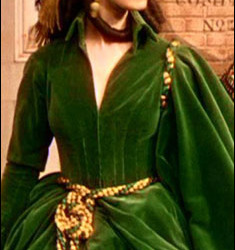


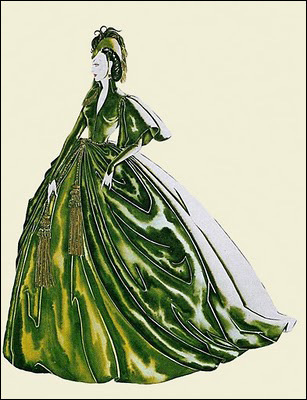

“The Green Curtain Dress,“ arguably one of the most iconic costumes ever created for one of the most famous films ever to be produced by Hollywood, has a history of recycling. It’s shocking to think that a gown that has become so iconic in our eyes would go on to be used again. We must remember that in an era when there were no DVDs, people saw a movie in the theater and then never saw it again, making a costume difficult to be remembered in vivid detail. If the film was extremely popular it might go on to be released a few years later (and in the case of Gone with the Wind, it was), but by and large, people would see a film in the theater, and that would be the last they would see of it. Gone with the Wind reused many of its costumes, including Scarlett’s paisley dressing gown and her green bonnet from Paris.
The costume was designed by the great Walter Plunkett for use on newcomer Vivien Leigh as Scarlett O’Hara in the 1939 film Gone with the Wind. At the time, Technicolor cameras made garments appear a different color on screen than they were in real life. For example, Dorothy’s famous “Ruby Slippers” are in fact more of a burgundy color. Plunkett had the task of getting the green to look the proper color in technicolor, getting the green to make Vivien Leigh’s blue eyes appear greener on screen, and fading the dress in places to make it appear as if the sun had damaged them while hanging in the window. At the first two tasks, Plunkett succeeded admirably, but the fading does not appear on camera, and the gown appears a uniform, brilliant green.
It is not known how many copies of the curtain dress were produced. Just as today, multiples of a costume were frequently created for stunt doubles or body doubles. One of the costumes does seem to have gone on to be altered and used in the 1946 film Bedlam on Anna Lee as Nell. The film is in black and white, and so the brilliant color of the piece is not seen, though a lobby card colors it incorrectly as red. The gown has clearly undergone some adjustments. The hoop skirt is no longer worn, and thus the skirt falls much differently. The caplet on the left shoulder has been removed, large cuffs have been added to the end of the sleeves, and the cording around the waist and shoulder have been removed. However, looking at the collar and the seams of the dress make it obvious that it is indeed the same costume – a fact that is confirmed in the audio commentary of Bedlam.
One copy of the curtain dress was eventually put into storage in the David O Selznick collection at The Harry Ransom Center in Texas, where $30,000 was raised for its restoration so that it could go on display for the 75th-anniversary exhibit "The Making of Gone with the Wind.” To properly restore the gown, Textile Conservator Cara Varnell had to take great pains in determining what was original to the dress and what was not. Of the dress at the Ransom Center, she says:
There are several rows of machine stitching on the waistline that don’t make sense. There are extensive alterations, and it’s not clear when or why they were done.
Nicole Villarreal, a Textiles and Apparel Technology student who helped to do a complete study and catalog of the dress, documenting which threads were original and which were added at a later date notes of the gown:
If you look at the movie stills, the skirt is bell-shaped. But if you look at the dress now, the twill tape makes it more of an A-line skirt. Also, the front hem of the dress doesn’t have an undulating wave in the movie stills, but it does now with the hoop in it.
We may never know why these alterations were done. Is the gown that the Ransom Center owns the same one used in Bedlam? Likely not, though the changes suggest that the Ransom Center’s version of the dress may have been utilized in another production as well – or at the very least altered for different displays when the dress traveled across the country on tours early during the release of Gone with the Wind. Either way – one of the copies of the “Curtain Dress” used in Gone with the Wind went on to be used in Bedlam, and the dress owned by the Ransom Center is a great reminder that even the most special pieces get altered and changed.
75 years later the gown has become iconic. Designer Bob Mackie created his own parody version of the curtain dress for The Carol Burnett Show skit “Went With the Wind,” and the gag costume has become iconic in its own right.
To learn more about the conservation of this fantastic dress, visit the blog at the Harry Ransom Center. To find out more about seeing this dress in person at “The Making of Gone with the Wind” exhibit, visit the exhibit’s Official Page. You can also watch Carol Burnett’s “Went with the Wind” sketch online, as well as see an interview with Carol Burnett and Bob Mackie discussing the creation of the costume.
Costume Credit: James, James L. Tumblin
E-mail Submissions: [email protected]
Follow: Website | Twitter | Facebook | Pinterest
Note: This post has been re-blogged from our archives. New updates will resume next week.
377 notes
·
View notes
Photo

RUSH IT (1977)
COMEDY LEGEND HENNY “TAKE MY WIFE, PLEASE” YOUNGMAN HAS A SON NAMED GARY. I’M GONNA GO OUT ON A LIMB AND SAY THAT GARY WAS ONE OF THOSE FREE-SPIRITED CELEBRITY KIDS OF THE 1960s/70s, YOU KNOW THE KIND. AN AGITATOR, EVER PLAYING HIS PAN FLUTE FOR THE PEOPLE, JUST HIM AND HIS TRUST FUND AGAINST THE WORLD. THE WORLD, IN GARY’S CASE, WAS NEW YORK CITY. BUT OFF-OFF BROADWAY WASN’T HIS BAG, SO GARY CROSSED OVER INTO FILMMAKING. OLD MAN YOUNGMAN GAVE HIM THE GREEN LIGHT, LINED UP THE FINANCIERS AND GARY SHOT RUSH IT WITH ALL HIS NEW YORK ACTOR FRIENDS, IN HOPES OF USING THE MATERIAL LIKE A 78-MINUTE TALENT REEL. THE CAST INCLUDES FUTURE HOLLYWOOD HEAVYWEIGHTS LIKE TOM BERENGER (THE BIG CHILL), JOHN HEARD (CUTTER’S WAY) AND JILL EIKENBERRY (TV’s “L.A. LAW”). AFTER VIACOM ACQUIRED RIGHTS TO THE FILM, RUSH IT PLAYED A LOT ON MOVIE CHANNELS LIKE SHOWTIME. THE SOLE VIDEO RELEASE OF RUSH IT CAME IN THE FORM OF A BIG OL’ CLAMSHELL VHS FROM UNICORN VIDEO, MARKETED AFTER TOM BERENGER’S CAREER TOOK OFF. I TRACKED DOWN A COPY OF THE TAPE AT EDDIE BRANDT’S SATURDAY MATINEE.

RUSH IT IS ABOUT A CAREFREE FEMALE BIKE MESSENGER (JUDY KAHAN) MAKING HER WAY IN THE CITY. SHE’S GOT THAT QUASI-ANNOYING ANNIE HALL THING GOING ON, IF A LITTLE MORE JEWISH AND, WELL, BASICALLY HARMLESS BECAUSE SHE’S IN HER TWENTIES AND ISN’T ANYONE’S MOTHER YET. SHE RIDES AROUND MANHATTAN IN A DUMB HAT, SMILING AT EVERYTHING WHILE BUZZY LINHART’S EBULLIENT SONGS BLAST OVER THE SOUNDTRACK. COULD BE WORSE. I MEAN, THE WORLD DIDN’T COMPLETELY SUCK BACK THEN. SURE, WE THOUGHT IT DID. OH, DID WE EVER! WE THOUGHT IT WAS OVER, MAN. THE SIXTIES WERE OVER. THE SIXTIES WERE GREAT! THE SEVENTIES WERE FAR WORSE. THESE WERE THE POST-WATERGATE YEARS. NEW YORK WAS ONE BROKE-ASS TOILET, AND YET IT WAS KIND OF MAGICAL, TOO.
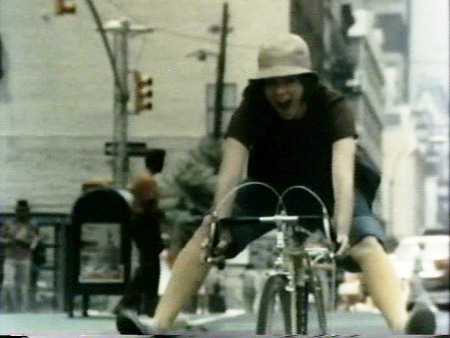
DISCLAIMER: NO ONE WHO APPEARS IN RUSH IT WAS EVER A BIKE MESSENGER. REAL BIKE MESSENGERS DON’T KICK THEIR FEET UP WHILE TRAVERSING DANGEROUS METROPOLITAN TERRAIN, THEY RUN RED LIGHTS, FLIP STRANGERS THE BIRD AND DRINK FORTIES IN THE PARK. IF ANYONE HAS ANYTHING TO SAY ABOUT THAT, A GANG OF THESE CATS WILL APPEAR OUT OF NOWHERE, UNBUCKLE THE SEATBELT STRAPS ON THEIR MESSENGER BAGS, MOVE FOR THEIR CHAIN WALLETS AND REENACT A SCENE FROM THE ‘96 X-GAMES. REMEMBER PUCK FROM MTV’s “THE REAL WORLD”? THAT’S A FUCKING BIKE MESSENGER! INCORRIGIBLE, UNREPENTANT B.Y.O.B. PUNKHOUSE SNOTROCKET RASCALS.


“How ‘bout a date tonight, bimbo?”
THIS LUNATIC PLAYS THE PERVED-OUT DISPATCHER AT THE MESSENGER SERVICE. APPARENTLY JOE SPINELL WAS NOT AVAILABLE FOR THE ROLE, SO GARY CAST SOME ELEVATOR MAN WITH A CHECKERED PAST INVOLVING MANY INCIDENTS OF PUBLIC MASTURBATION. HE’S THE MOST AUTHENTIC SLICE OF THE APPLE IN THIS TURKEY. WHY CAN’T THE MOVIE BE ABOUT HIS TRIALS AND TRIBULATIONS? LET’S FOLLOW HIM AROUND WHILE HE’S HAGGLING OVER THE PRICE OF A PAPAYA AT HIS LOCAL BODEGA OR CHECKING OUT THE SNATCH ON 42nd STREET.

HERE’S TOM BERENGER DOING HIS BEST BOTICELLI POSE FOR SOME LITTLE CHINA GIRL. BERENGER’S CHARACTER IS A STALLION WHO PREYS ON CITY CHICKS WITH HIS LOOKS, ESCHEWING ALL STRINGS IN THE CLASSIC LOVE ‘EM AND LEAVE ‘EM STYLE. HIS PREFERENCE, ADMITTEDLY, IS FOR “MORE MATURE WOMEN... ESPECIALLY MARRIED ONES.” YEP, IN THE END, HE’S JUST A GIGOLO. OH, BUT WHAT HE REALLY WANTS TO BE IS A FAMOUS PAINTER!

BERENGER TRIES TO PICK UP JUDY, BUT SHE’S HIP TO HIS ACT AND SPEEDS OFF ON HER BIANCHI. THEN SHE BUMPS INTO AN OLD BOYFRIEND, SOME SUIT WITH A FOXY ITALIAN BROAD ON HIS ARM. JUDY CALLS HIM A HEEL AND KEEPS ON PUSHING. SHE DELIVERS SOME SHIT TO SOME ECCENTRIC IDIOTS, INCLUDING A DRUGGED-OUT TALENT AGENT (ANTHONY HOLLAND, ALL THAT JAZZ) AND GAGGLE OF SUFFRAGETTES WHO’VE BEEN CRYOGENICALLY FROZEN IN A GREENWICH VILLAGE APARTMENT SINCE 1917. JUDY TAKES A BREAK AND GOES HOME. HER PAD HAS SOME FABULOUS TOKENS OF SEVENTIES SINGLE GIRL CHIC, INCLUDING HANGING HOUSE PLANTS, CINDER BLOCK BOOK SHELVES AND FRAMED PICTURES OF JANE AUSTIN. SHE RECEIVES A VISIT FROM HER NEIGHBOR, BYRON (JOHN HEARD), WHO’S JAZZED ON SOME GIRL HE JUST MET. JUDY AND BYRON ARE PLATONIC FRIENDS BECAUSE JUDY, WE’RE LEARNING, IS KIND OF A DYKE; NOT SO MUCH IN THE SEXUAL SENSE, BUT IN THE CULTURAL ONE. SHE’S TOTALLY FINE BEING ONE OF THE GUYS UNTIL THE RIGHT ONE COMES ALONG.


THE SUMMER I EXCAVATED RUSH IT FROM THE TOMB-LIKE STACKS AT EDDIE BRANDT’S, I WAS OBSESSED WITH THE ACTOR JOHN HEARD’S EARLY CAREER. IT STARTED WHEN I SAW HIM IN CHILLY SCENES OF WINTER, THEN GREW WITH BETWEEN THE LINES AND CUTTER’S WAY, THEN CONTINUED ON THROUGH A SLEW OF EXEMPLARY ROLES IN NOT-SO-GREAT FLICKS LIKE FIRST LOVE, ON THE YARD, BEST REVENGE, HEART BEAT, AND CAT PEOPLE. DUDE HAD CHOPS, CHARM AND AN IRRESISTIBLY SELF-EFFACING WIT. BY THE TIME HE WAS CAST AS JACK KEROUAC IN HEART BEAT, STARRING OPPOSITE NICK NOLTE AND SISSY SPACEK, HEARD WAS WELL ON HIS WAY TO BECOMING A LEADING MAN. BUT I SUSPECT HE NEVER FELT COMFORTABLE WITH THE HOLLYWOOD MACHINE, HAVING COME OUT OF THE LESS BULLSHIT-Y WORLD OF NEW YORK THEATER. IN THE EARLY EIGHTIES, HEARD ATE AND DRANK HIMSELF OUT OF THE RUNNING. THANKS TO THIS SELF-SABOTAGE, TODAY HEARD IS BEST KNOWN TO THE IDIOTS WHO COMPRISE 99% OF THE MOVIE-GOING PUBLIC FOR PLAYING MACAULEY CULKIN’S DAD IN THE HOME ALONE FLICKS.


BYRON INVITES JUDY TO SOME GET-TOGETHER AT HIS GIRLFRIEND’S PAD. MERRILL (JILL EIKENBERRY) IS A SECRETARY, ER, ADMINISTRATIVE ASSISTANT WHO’S REAL HUNG UP ON THAT POST-ROTHKO ABSTRACT SHIT AND ITS MARK ON THE THEN-EMERGING BOURGEOIS HOBBY KNOWN AS DECORATING. FROM THIS INTRODUCTION ONWARD, WE HAVE NO IDEA WHAT BYRON SEES IN MERRILL. HE SHOULD REALLY JUST GO FOR JUDY, WHO WEARS OVERALLS TO PARTIES AND IS CLEARLY A GAS.

JUDY MEETS A CHARMING 28-YEAR-OLD JEW NAMED MARK, WHO’S, OF ALL THINGS, A DENTIST. WOW! EDGY! SO THIS GUY STARTS PULLING A LOT OF NUMBERS WITH JUDY, AND SHE’S KINDA DIGGIN’ IT. THEY MINGLE AND GET COZY. THE COMBINATION OF GOD’S EYE AND CARLO ROSSI IN THE ABOVE FRAME IS FABULOUS.


MARK’S “BLEEPER” GOES OFF, AN EMERGENCY BACK AT THE OFFICE, AND HE LEAVES JUDY WITH A SEMI.
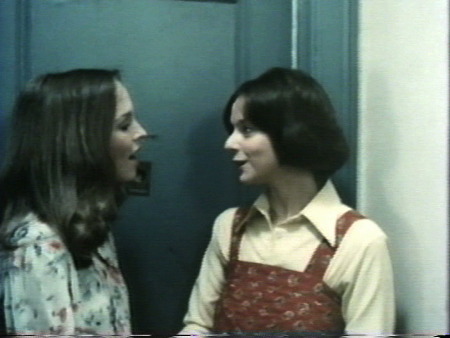
THEN MERRILL MENTIONS TO JUDY THAT MARK IS MARRIED. JUDY’S LOOKING GOOOOOOD IN THOSE OVERALLS, AIN’T SEE? I WONDER IF LENA DUNHAM EVER SAW THIS MOVIE.
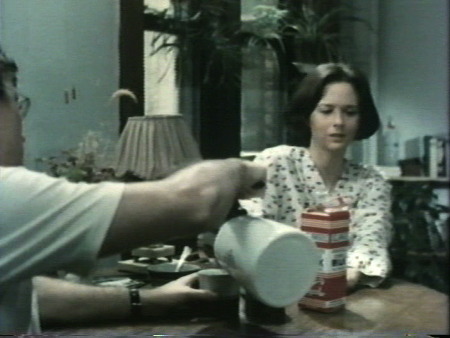
THE NEXT MORNING, BYRON COMES OVER TO GET A RECAP OF JUDY’S EVENING. THE USZH, SHE’S STILL 25 AND SINGLE.

THIS IS WHAT A DOOR IS SUPPOSED TO LOOK LIKE. IF YOU’RE UNDER 30 AND THE DOORWAY OF YOUR BIG CITY APARTMENT DOESN’T LOOK LIKE THIS, YOU’RE WASTING YOUR PARENT’S MONEY. THIS BARE BONES ASSEMBLAGE IS ALL YOU NEED TO PARTY LIKE A TRUE BELIEVER: OLD TERMITE-INFESTED WOOD PAINTED A MILLION TIMES OVER, QUESTIONABLY SECURE, DIRTY AND DELIGHTFUL. MY OLD SPOT LOOKED LIKE THIS. THEN I MOVED. NOW, FOR A MERE $1,000 MORE A MONTH, I GOT ONE OF THEM NEW CHINESE JOBS MADE OUT OF RECYCLED AMERICAN REFUSE AND PARTICLE BOARD, PLASTIC WINDOW SLATS FROM HOME DEPOT (ALSO MADE IN CHINA!), THE WHOLE PATHETIC PACKAGE.
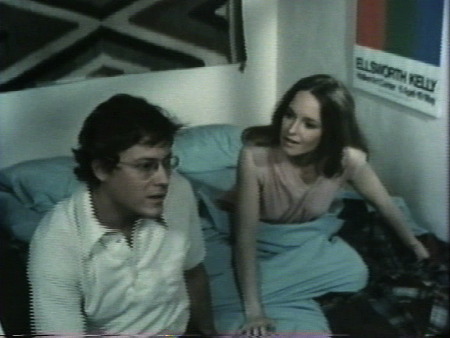
BYRON’S NEW GIRL STARTS GETTING UPPITY ABOUT BYRON’S ASSOCIATION WITH JUDY. JUST WHAT TYPE OF PERSON CHOOSES TO BECOME A BIKE MESSENGER, PRAY TELL? BYRON REVEALS JUDY HAS HER MASTER’S DEGREE, SHE’S JUST DOING THE BIKE GIG COS HER DEGREE IS TOTALLY WORTHLESS AND IT’S FUN RIDING A BIKE IN A CITY YOU CAN SMILE AT COS YOU REFUSE TO BELIEVE THAT ALL MEN ARE RAPISTS, DESPITE CONVENTIONAL WISDOM AND SECOND WAVE FEMINISM STATING OTHERWISE.
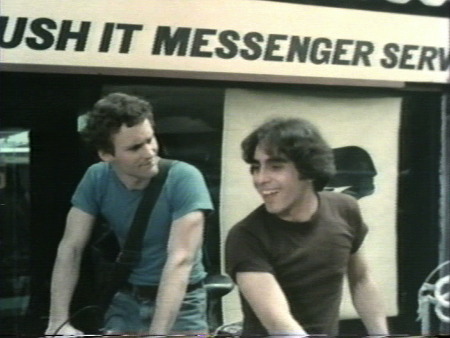
BACK AT THE BIKE SHOP, THESE TWO JOES PRACTICE THEIR HIGH NOTES FOR SOME FUTURE “CATS” AUDITION.
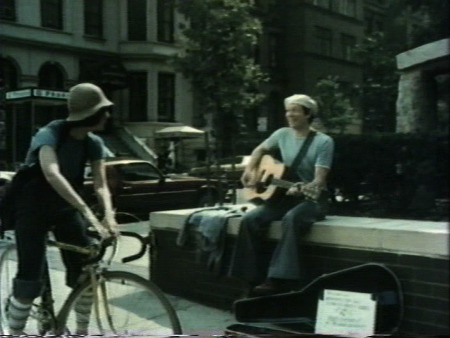

JUDY SPOTS BUZZY LINHART BUSKING. ALRIGHT! BUZZY KNOWS WHERE IT’S AT.
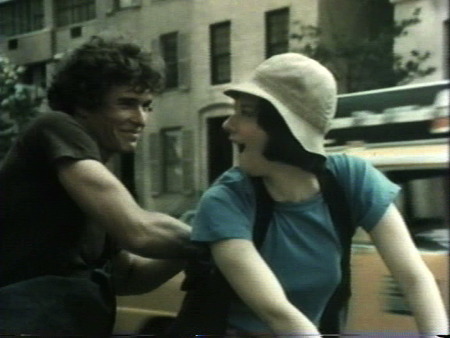
BERENGER FINALLY GETS THE BEST OF JUDY. HE WRITES HIS NUMBER ON HER BACK AND TELLS HER TO CALL HIM. THAT NIGHT, SHE HAS TO READ IT IN A MIRROR AND INVERT THE DIGITS. TWICE SHE CALLS THE WRONG NUMBER, FIRST IT’S SOME PEPE PERSON AND THEN A PHILIPINO WITH CATFISH WHISKERS. SO JUDY AND BERENGER GO OUT AND BALL. PRETTY SOON, THEY’RE AN ITEM.

BERENGER SHOWS JUDY HIS WORK. HE’S INTERRUPTED BY THE TELEPHONE. IT’S TOM’S OF FINLAND CALLING, ASKING WHERE THE SAILOR’S CAP WENT.

BERENGER TELLS JUDY A BUNCH OF SHIT ABOUT WHAT A SHITTY, SELF-ABSORBED PERSON HE IS -- JUST A SLAVE TO THE MUSE, MAN. BUT HE’S A STALLION, SO JUDY DIGS HIS FEARLESS HONESTY AND ACCEPTS BERENGER IN SPITE OF HIS MANY SHORTCOMINGS.
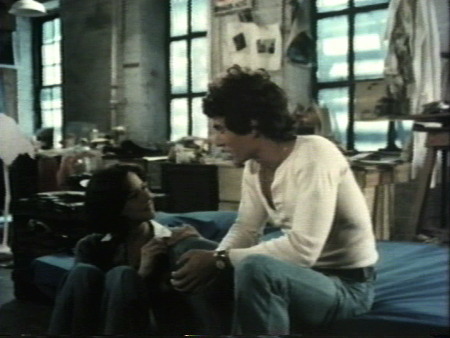
BERENGER ALSO TELLS JUDY HE’S BROKE AND MIGHT BE MOVING TO PENNSYLVANIA TO LIVE ON A FARM WITH AN AMISH COUPLE HE MET AT NIAGARA FALLS. THAT IS, UNLESS JUDY WILL LET HIM MOVE HIS ART STUDIO INTO HER APARTMENT.

MORE SUPERFLUOUS BERENGER PORN.

JUDY BUMPS INTO BYRON OUTSIDE THEIR BUILDING. HE’S WEARING A SUIT, WHICH INDICATES HE HAS A REAL JOB, PROBABLY IN AN OFFICE WHERE THE EXECS WITH THE GRAYING SIDEBURNS DRINK ALL DAY AND GRAB-ASS WITH THE LITTLE CHIQUITAS IN THE TYPING POOL.

BACK AT HER PLACE, JUDY RAPS TO BYRON ABOUT HER NEW STUD AND HOW TO KEEP HIM. BYRON SUGGESTS A FAKE PREGNANCY.

THEN, APROPOS OF NOTHING, BYRON DOES A REALLY BAD BRANDO IMPRESSION. THIS IS IN NO WAY INDICATIVE OF JOHN HEARD’S TALENT AS AN ACTOR.

BERENGER COMES OVER AND STARTS MOVING JUDY’S STUFF AROUND. JUDY DIGS BERENGER’S TAKE-CHARGE ATTITUDE.
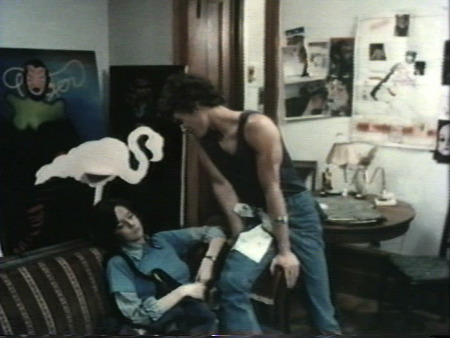
BYRON AND MERRILL HELP MOVE THE REST OF BERENGER’S SHIT OVER. JUDY, MEANWHILE, IS GROWING WARY OF BERENGER’S OPPORTUNISM.

THE NEXT EVENING, BYRON AND MERRILL INVITE JUDY AND BERENGER OVER FOR SUPPER. BERENGER WEARS SOME GONDOLIER’S SHIRT WITH A FUCKING POCKET ON THE ARM FOR HIS SMOKES. AFTER SOME WINE, MERRILL STARTS HITTING ON BERENGER. SHE ASKS HIM IF HE’LL DIG HER PAINTINGS AND LET HER KNOW WHAT HE THINKS. THEY REALLY SUCK. NO ONE SAYS THAT, BUT OF COURSE THEY DO. THEN MERRILL ASKS BERENGER IF HE GIVES PRIVATE LESSONS.


BACK AT WORK, JUDY DELIVERS SOME FILM TO A CASTING AGENCY. THE MANIAC WHO RUNS THE PLACE FLIRTS WITH JUDY. I DON’T KNOW WHY THIS SCENE IS IN THE MOVIE, EXCEPT TO FLESH OUT ITS ALREADY TOO-SHORT RUNNING TIME.

AT HEADQUARTERS, JUDY JOKES AROUND WITH THE HORNY DISPATCHER, WHO SAYS HE WON’T ASK HER OUT ANYMORE SINCE HE KNOWS JUDY’S BERENGER’S OLD LADY.
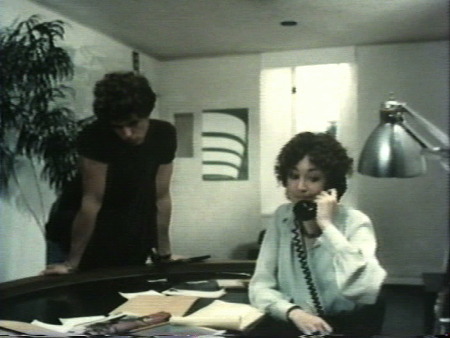
WE GET TO SEE BERENGER RUSH IT A BIT, TOO. HE DELIVERS A PACKAGE TO SOME OFFICE, WHERE AN OLDER, STILL-FOXY SECRETARY REPEATEDLY ASKS HIM WHAT SHE CAN DO FOR HIM. ALL HE NEEDS IS HER SIGNATURE, BUT HE ASKS HER OUT FOR AN EGG McMUFFIN. GUESS WHO’S BUYING?

THEN BERENGER CRASHES SOME ART OPENING, APPROACHING THE OWNER OF THE GALLERY WITH HIS SLIDES IN TOW LIKE A TOTAL ASSHOLE. THE OWNER TELLS BERENGER HE’LL HAVE TO SPEAK TO HIS WIFE (CHRISTINA PICKLES, THE WEDDING SINGER), WHO, IN FACT, RUNS THE GALLERY.
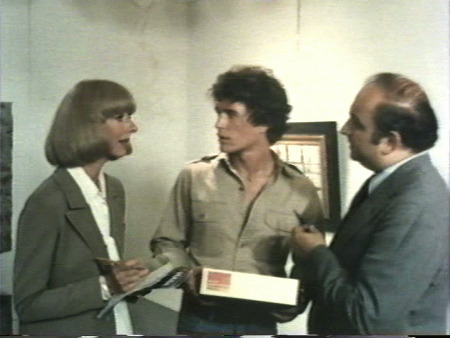
WHEN THE GALLERY GASH FEASTS HER EYES ON BERENGER, SHE QUICKLY STARTS ASKING ABOUT HIS WORK AND ITS DIMENSIONS.

WHEN SHE’S SATISFIED, THEY MAKE A DATE FOR A STUDIO VISIT.

BERENGER RETURNS TO JUDY’S PAD ELATED WITH THE GOOD NEWS. JUDY’S HAPPY FOR HIM, BUT ALSO KIND OF BUMMED THAT HE DIDN’T TAKE HER TO THE OPENING.

JUDY AND BYRON HAVE A CHAT ON THE WAY TO THE LAUNDROMAT. BYRON REVEALS THAT HE’S PLANNING TO BREAK UP WITH MERRILL.
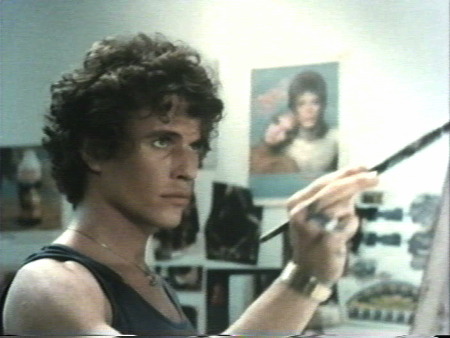
WHILE JUDY’S OUT DOING HER OLD MAN’S WHITES, SAID OLD MAN SLAVES AWAY IN THE STUDIO THAT USED TO BE JUDY’S APARTMENT. DIG BOWIE’S PINUPS IN THE THE BACKGROUND!
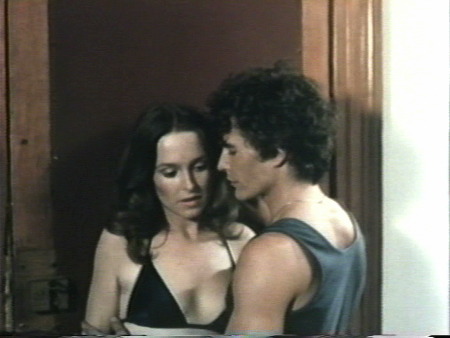
BERENGER RECEIVES AN UNEXPECTED VISIT FROM MERRILL, WHO’S BEEN SUNBATHING ON THE ROOF. SHE ASKS BERENGER IF SHE CAN WATCH HIM PAINT. HE TELLS HER TO COME BACK WHEN IT’S A BETTER TIME TO PARTY, HE’S ON A DEADLINE.
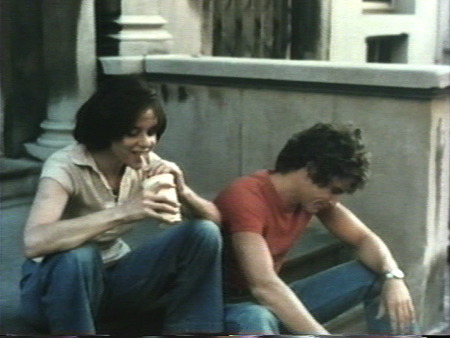
JUDY AND BERENGER GRAB SOME MALTS AND PARK IT ON THE CURB. THE LIGHT’S REAL NICE AND THE WIND’S BLOWING SOFTLY, MAKING THE SCENE PLAY MORE NATURAL THAN THE OTHERS. IF I WAS ONE OF THESE TWO PEOPLE, I’D CHOOSE THIS SCENE FOR MY ACTING REEL.
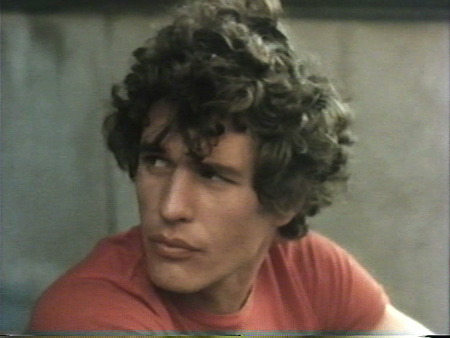

WHEN JUDY TELLS BERENGER THAT BYRON’S CUTTING MERRILL LOOSE, HE ISN’T SUPRISED. HE TELLS JUDY HE’LL NEVER LET SOME CHICK COME BETWEEN HIM AND HIS PAINTING.

“Don’t EVER buy me a strawberry shake again. I said VANILLA.”


BERENGER PICKS A CONVENIENT TIME FOR THE GALLERY GASH TO STOP BY -- i.e. WHEN JUDY AIN’T AROUND. SHE DIGS BERENGER’S WORK AND BEGS FOR A CLOSER LOOK.
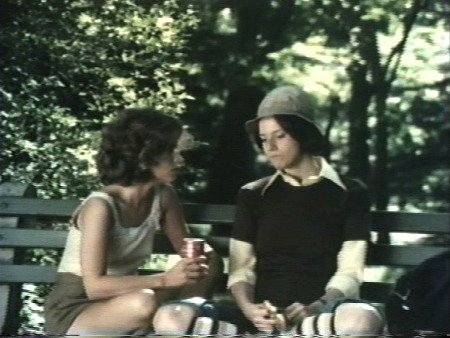
JUDY AND HER GIRLFRIEND FROM THE MESSENGER OFFICE (HARRIETT HALL) GET TOGETHER IN THE PARK TO RAP ABOUT BOYS AND WHAT HEELS THEY ARE.

WHEN JUDY GETS HOME, SHE FINDS BYRON MOROSE AND CARRYING A BOX OF MERRILL’S SHIT TO DELIVER BACK TO HER. BYRON ASKS JUDY IF SHE’LL COME WITH HIM.

WHEN THEY GET TO MERRILL’S, BYRON TELLS JUDY HER COMING WITH HIM WAS JUST A PLOY TO GET HER TO ACTUALLY DELIVER THE SHIT HERSELF SO BYRON WON’T HAVE TO SUFFER THE AGONY OF SEEING MERRILL’S STUPID FACE ONE MORE TIME. JUDY, EVER THE GOOD SPORT, OBLIGES HIM.

“Oh... it’s you. Where’s Byron? OH. Okay. Well, can you tell him he still owes me $4.37 for his portion of the Con Ed bill from July? Thanks!”

AS JUDY AND BYRON RETURN TO THEIR BUILDING, THE GALLERY GASH IS JUST LEAVING.

B-B-BUSTED! WHEN JUDY ENTERS THE PAD, BERENGER’S IN THE PROCESS OF CHANGING HIS SHIRT TO ONE NOT SOAKED IN SWEAT AND SCENTED VAGINAL OILS. HE TELLS JUDY HE GOT THE SHOW. SUDDENLY, WITH THE HELP OF A SHORT FLASHBACK, JUDY KNOWS THE SCORE.
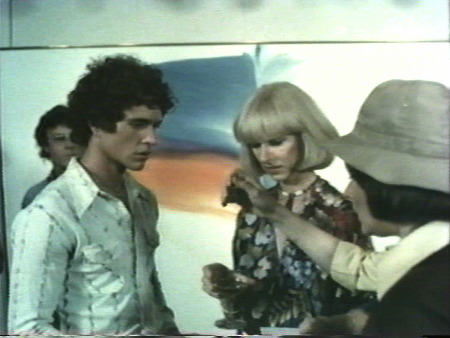
AFTER A LONG, CATHARTIC RIDE AROUND THE CITY, JUDY VISITS THE GALLERY WHERE BERENGER’S GONNA HAVE HIS SHOW. THE PAINTINGS IN THE BACKGROUND REMINDS ME A LOT OF THE KIND OF WORK ALAN BATES’ CHARACTER MADE IN AN UNMARRIED WOMAN, OR THAT ARTIST JEREMY BLAKE WHO ESSENTIALLY MADE THE SAME KIND OF SHIT IN THE EARLY 2000s, ALBEIT DIGITALLY, BEFORE HIS TRAGIC DOUBLE-SUICIDE WITH HIS CRAZY WIFE AFTER THEY DID TOO MUCH COCAINE AND CONVINCED THEMSELVES THEY WERE BEING HUNTED BY THE CHURCH OF SCIENTOLOGY. IF THIS REVIEW HAS TAUGHT YOU ANYTHING, IT’S THAT I KNOW FAR TOO MUCH BULLSHIT ABOUT CONTEMPORARY ART AND NOT ENOUGH ABOUT MAKING LOVE. ANYWAY, JUDY WINS.

SHE GOES FOR ONE LAST DELIVERY. ONCE AGAIN, BUZZY LINHART’S MUSIC COMES ALONG FOR THE RIDE.


FINALLY, BYRON TELLS JUDY HE’S FOUND THE PERFECT GUY FOR HER: IT’S BYRON!!! WELL, ALRIGHT! JUDY LAUGHS. HARD. THE END.
9 notes
·
View notes
Text
The Down And Dirty History Of TMZ
New Post has been published on https://kidsviral.info/the-down-and-dirty-history-of-tmz/
The Down And Dirty History Of TMZ
How a lawyer from the San Fernando Valley created a gossip empire and transformed himself into the most feared man in Hollywood, all by breaking a few long-held rules and, as rumor has it, lording over a notorious vault full of secrets.
For just $53, you can purchase a guaranteed front-of-the-bus seat on the TMZ NYC Tour. After stepping on the bus in the middle of Times Square, a TMZ-trained tour guide — handsome, blond, amiable Australian — will ask you and the rest of the bus if you’re a huge fan of the show. You’ll clap; the rest of the bus will roar in agreement. When a tanned, smiling face shows up on the television screen above your seat, you’ll be prompted to cheer for “our fearless leader, Harvey!” — and laugh when the guide promises to show you “all the places where celebrities party and bone and get diseases.” Here on the bus, you become one of TMZ’s people — the ones who’ve helped turned a gossip website into a $55 million yearly enterprise.
The TMZ tour gives the same experience of a generic Manhattan tour — the story of Times Square, which, in the guide’s words, “isn’t just home to 1,000 illegal immigrants working as Disney characters”; a quick turn through the Meatpacking District; a view of Central Park — only punctuated with landmarks of celebrity significance, introduced with TMZ’s trademark leering tone. While driving along Broadway: “Ladies, dry off your seats, James Franco’s on Broadway! And if you’re under 16 on Instagram, he’s probably tried to have sex with you!” While passing ABC studios: “Here’s the set of Good Morning America, where Chris Brown is known for his hits!”
Halfway through the three-hour tour, the bus stops in SoHo: To the left, there’s DASH, the Kardashian-branded store; to the right, you can backtrack to the loft where Philip Seymour Hoffman was found dead of a heroin overdose.
These two attractions perfectly encapsulate two of the modes of coverage at which TMZ excels: the frivolous and the macabre, Celebrity Banality News and Celebrity Death News. But there’s a third TMZ mode, one that neither the tour nor the TMZ syndicated program can truly translate. It’s this mode that distinguishes TMZ from all other celebrity news sites — what gives it teeth or, more precisely, bite. It’s not the TMZ-employed paparazzi trailing B-listers at the airport, photos of hot celebrities at the beach, or mugshots of celebrity stalkers.
TMZ’s real engine — what defines its mission, what legitimizes it and sets it apart — is a unique and controversial mix of scandal mongering and investigative journalism. But it’s also that mode that some have claimed is responsible for acquiring a video of Justin Bieber telling a racist joke and, over the course of four years, not publishing it.
BuzzFeed spoke to nearly two dozen former TMZ employees, and it’s clear that Bieber’s tape was not the only near-priceless piece of dirt in the proverbial TMZ vault. (TMZ did not respond to multiple requests for comment.) According to these ex-employees, the sealed testimonies from the Michael Jackson molestation trial hide there as does footage of various celebrities — Bieber, Lohan, Travolta — behaving badly. The vault isn’t a secret at TMZ — even the lowest on the staff ladder have heard whispers of its existence. As to what goes up on the site and what stays vaulted, that’s a finer, more esoteric calculus — and one in which celebrities and their publicists have come to live in fear. As one source explained, “There’s no doubt: [Harvey] Levin absolutely changed the way celebrities function today.”
TMZ has been responsible for breaking the biggest celebrity scandals of the last 10 years: effectively ending a 30-year career (Mel Gibson), tarnishing golf’s most sacred idol (Tiger Woods), and puncturing the pristine image of celebrity royalty (Solange Knowles attacking Jay Z). But it’s not just celebs: In 2009, it caught a bank spending millions of taxpayer bailout funds on a lavish party (Northern Trust), and, via spin-off TMZSports, instigated the $2 billion sale of an NBA team by applying the same surveillance to a racist owner (Donald Sterling) once reserved for the Hollywood stars and socialites.
Before TMZ, the gossip landscape was predominantly characterized by what those in the industry call “blow job news” — tidbits and sound bites that flatter the egos and images of celebrities. But TMZ disrupts that. It trades in scandal, and revels in exposing the narrative for what it is: a story as fictional as the films and television shows in which these stars appear. It didn’t just revise the accepted notion of what “Mel Gibson” means. It immolated it.
In the first five years of its existence, TMZ became the new standard not only for scandal mongering and gossip gathering, but multiplatform brand dominance. But its quest to become the “future of entertainment news” seems to have leveled out a bit. According to Quantcast, unique traffic has increased just 11% over a two-year period (24.48 million to 27.23 million; compare to usmagazine.com, whose unique traffic has increased 156%, from 12.8 million to 32.8 million) and Famous in 12, a TMZ-branded CW series, was canceled after five episodes this summer.
In 2007, though, TMZ did indeed look like the future. And even if that status is less certain today, TMZ has been the most influential and important media organization of the last decade. It’s not in good taste. It’s brazen, proud of its gaudiness. It’s altered the way that news about celebrity is treated, spread, and consumed — and earned its place in a lineage, spanning from Confidential magazine to the National Enquirer, that turns “celebrity gossip” into serious investigative journalism impossible to ignore.
But TMZ’s remarkable success and reputation have come at a price, as the demand to acquire and “own” scoops while simultaneously catering to a demographic of untraditional (read: straight male) gossip consumers has transformed a rag-tag group of reporters invested in illuminating Hollywood hypocrisy into a cabal of ruthless, click-hungry, and aggressive TMZers with little journalistic training and a tolerance of misogyny, both within the workplace and on the site and television show.
TMZ is both better and worse than you thought it was. In the words of a former staffer, “We built a brand that turned into a monster that can run on its own.” It’s a well-oiled, money-making, gossip-generating machine. But has it compromised the mission that set it apart from the rest of the gossip industry?
To answer that question, we have to look closely at the story of TMZ — its founding narrative, its breakthrough, and, most crucially, its founder — the man for whom the bus of TMZ acolytes cheered so emphatically. Because as anyone affiliated with the site will tell you, the story of TMZ is really the story of Harvey Levin.
View this image ›
FameFlynet (Travolta, Lohan), Handout / Reuters (Bieber)
Harvey Levin grew up, in the words of one former associate, as a “Jew nerd from Reseda, Calif.” — in proximity to the glamour of Hollywood, but definitively excluded from it. He was short, smart, and savvy, and spent his childhood observing his father, who owned a liquor store, attempting to avoid selling booze to kids with fake IDs, while the cops indiscriminately chose when to prosecute and when to look the other way. According to this confidant, this experience would motivate and structure Levin’s career, as he worked to expose the hypocrisy of those in power, whether they be the police, celebrities, or the various apparatuses that supported and sheltered them. He received a B.A. from UC Santa Barbara and a J.D. from University of Chicago, passing the California bar in 1975.
View this image ›
KCBS
Levin taught law and briefly practiced it, but starting in 1982 began focusing on his media career: He had a legal radio talk show, a column in the Los Angeles Times, and law-related reporting gigs at KNBC and later KCBS, which is where he was working when the biggest celebrity scandal of the ‘90s broke: the O.J. Simpson trial. He was but one player in the larger industry that popped up around the trial and its aftermath, but he was skilled enough — and natural enough on camera — to win the role of host of the revival of The People’s Court. In 2002, he became the executive producer of Celebrity Justice, but the show only aired for three years.
In these pre-TMZ years of Levin’s life, the building blocks of the TMZ empire are all visible: the obsession with hypocrisy, the keen understanding of the law, the application to celebrity, the tireless ambition. Levin was intelligent, but more importantly, he was telegenic, with the smooth talk of the most practiced lawyer and the charisma of a television star. After Celebrity Justice was canceled, he began making regular appearances on CNN’s Showbiz Tonight, but, according to a confidant, he wanted something of his own — which is why he said yes when Jim Paratore, head of Time Warner-owned production company Telepictures, approached him with an offer.
Paratore had headed up Telepictures since 1992, putting in place a blockbuster slate of daytime syndicated programming (The Tyra Banks Show, The Rosie O’Donnell Show, The Ellen DeGeneres Show) along with primetime mainstay The Bachelor. But one of Telepictures’ longest-running and most reliable shows was Extra, an entertainment news program developed in 1994 to provide synergistic promotion across the sprawling Time Warner media conglomerate. In 2005, Extra had already been on the air for more than a decade, amassing a trove of old footage of celebrities, all ready to be recycled and exploited on the cheap.
Which is exactly what Paratore would have Levin do. When Time Warner merged with AOL in 2000, the idea was to use AOL’s internet muscle to exploit Time Warner’s media holdings. But the two companies had very different corporate climates, and struggled to foster the originally imagined cross-platform synergies. According to Jim Bankoff, then president of AOL (and current CEO of Vox Media), Bankoff hit it off with Paratore at a 2005 meeting between AOL and Warner Bros. executives designed to kindle increased collaboration. Paratore regaled him with stories of thousands of hours of unused Extra footage — the perfect candidate for an AOL collaboration. Neither Bankoff nor Paratore knew what, exactly, they wanted to do with that footage, save put it on AOL and establish a brand that was something other than “AOL Celebrity.” That vague, amorphous idea was enough to pique Levin’s interest.
Levin didn’t know anything about the internet and had no interest in cultivating a web presence. (Multiple sources confirm that even today, he still uses an AOL email address, and all tweets from his Twitter account are automatically generated.) But he’d have something approximating free reign — and the ability to mold the property into something to finally match his grand vision.
Plus, following the historic summer of 2005, gossip was percolating at an alarming rate. A cottage industry of blogs, almost entirely run by women and queer men wholly outside the industry, were exploiting that interest — most visibly Perez Hilton, but also D-Listed, Lainey Gossip, Pink Is the New Blog, Just Jared — all of which were proving, to the somewhat startled old guard of gossipmongers, that the future wasn’t in syndicated television or print, but online. Constantly updated, dynamic, with a strong authorial voice; snarky, immediate, and originating outside the carefully cultivated celebrity sphere.
These bloggers were defined by their outsider status — and their very lack of access — but that outsider status (and lack of capital) also proved problematic. Hilton, for example, was sued multiple times — more than once for copyright infringement. What these bloggers lacked was infrastructure and capital to expand and bolster their operations, all while keeping the same all-important outsider ethic.
Which is precisely what an operation housed at Telepictures, with the larger launching pad of AOL (which, in 2005, still boasted an amplifying power of 22 million subscribers), could achieve. Levin and Paratore brought along some staff from Celebrity Justice and Extra, including eventual TMZ personalities Mike Walters, whose father was an assistant sheriff in Orange County, and Evan Rosenblum. Rosenblum is son of former Warner Bros. television chief Bruce Rosenblum, and is also married to the daughter of People’s Court producer Stu Billett. The official staff eventually numbered a grand total of seven.
The site had a sketch of an overarching mission, but it still lacked a name — according to a former staffer, there’d been a discussion of “Crushed Candy,” but that was too girly. The name needed to be catchy, different, and, most importantly, short, so as to better facilitate views via the burgeoning mobile market. Someone pitched the idea to use “TMZ” — Hollywood shorthand for the “Thirty Mile Zone,” or “studio zone,” which historically delineated the boundaries for union-related rates within the industry and, in branding terms, connoted a mysterious sort of insider knowledge.
View this image ›
The only problem? The URL was already taken by an electronics company that went by the name of Team Minus Zero. According to a staffer from that time, Levin called the owner up and offered $5,000 for the URL — but without revealing who he was or what, exactly, the URL was for. The guy jumped at the offer, but Levin, according to a source, also knew that if he showed up with the cash in his Porsche, the URL owner would immediately up the asking price. His solution: Borrow a staff member’s totally average car. Hand over $5,000 in cash. The URL — and the brand — was theirs.
On Nov. 9, 2005, TMZ wasn’t even in beta, but it got its hands on something too big to wait for the official site launch: footage of the aftermath of a car crash involving Paris Hilton, her then-boyfriend Greek shipping heir Stavros Niarchos, Rod Stewart’s daughter Kimberly, and Laguna Beach star Talan Torriero. Evidence of celebutante Hilton behaving badly was at a premium, but this was something bigger: The video showed the Bentley, driven by Niarchos, crashing into a truck, leaving the site of the crash, nearly hitting a bystander, and later, once police had pulled the car over, Hilton blowing a kiss to the officers and saying, “We love the police.”
TMZ sent an email blast to the far corners of the American media, describing the video and noting, at message’s end, “There is no evidence on tape that the police ever conducted field sobriety tests on the driver.”
It was a splashy debut, bearing the hallmarks (video footage, celebrity shaming, prodding the Los Angeles Police Department) that would make TMZ famous — even if no one knew what TMZ meant. But it was a start.
View this image ›
TMZ Beta
When the beta version of the site went up in mid-November 2005, its identity was still unclear, packed with a scattershot mix of softball gossip (“Jessica Simpson and Nick Lachey Officially Separating”), trade news from a full-time industry reporter (“Can ‘Potter’ Save Hollywood from the Poor House?”), and true pabulum (“Stars Share Their Favorite Thanksgiving Memories and Plans: They’re Famous and They’re Thankful”).
The aesthetics that would go on to define the site are visible even then, albeit in slightly altered form: At first, yellow was the contrast color of choice, and would gradually transition to red, white, and black. The scheme (like both The Smoking Gun and the Drudge Report) is the inverse of pastel-bathed Perez, D-Listed, and Just Jared, as well as the cover schemes of People and Us Weekly. From the start, TMZ was working to cater to a market that it’s cornered today: male consumers, many of whom wouldn’t even consider what they were reading “gossip.” Today, 42% of TMZ’s readership is male; compare that to usmagazine.com (15%) and people.com (11%).
In these ways, TMZ bore a resemblance to another ideologically disruptive publication: Confidential magazine, which, over the course of the 1950s, exploited and amplified the anxieties of an American society very much in transition. Confidential’s style not only affected the rest of the gossip industry, but also catalyzed a radical reconceptualization of stars and the industry that had, to that point, served as the primary source of the American fantasy world — a description that could readily be applied to TMZ as well.
Because of laws governing the sale of “obscenity” through the mail, you couldn’t get a subscription to Confidential — it was sold, along with the other lowbrow publications, at drug stores and cigarette stands. No reputable company would advertise in it. But by 1955, it broke the record for single-issue sales, selling 3.7 million copies of its January issue. Confidential succeeded because it offered something novel, dirty, and unspeakably sexy: the truth, or at least some rhapsodic version thereof.
View this image ›
Or so it promised, right under its title: “Tells the Facts and Names the Names.” It told the fact of Liberace’s homosexuality and named the name “Frank Sinatra” as the man who ate a breakfast of Wheaties in order to maintain his virility. A magazine like Confidential might have thrived during any decade, but the cultural climate of the ‘50s fostered a stream of anxiety-producing issues, including the Red Scare, the Kinsey reports, and increasingly fraught race relations. Dozens of publications were reporting on those topics, but Confidential pressed each hot button vis-à-vis Hollywood stars, politicians, and socialites. And it was able to — at least in the case of the most prominent and visible subjects — because of a significant change in the way that Hollywood managed its stars and their behavior.
The intricate history of the studio system’s production of stars is filled with manipulation, cover-ups, excised histories, and a gossip press willing to overlook it all as it behooves its own interests. In the 1920s, a series of star-related scandals threatened to expose the industry to government-imposed censorship; to avoid that fate, the studios and the press that covered them agreed to a symbiotic relationship in which one would provide a constant stream of material about the stars and advertising dollars in exchange for the implicit understanding that the magazines would not print anything that contradicted the studio line of stars as moral exemplars. If and when the stars did misbehave, each studio employed “fixers” to cover up the evidence (which included bribing cops, paying off mistresses, and arranging for abortions).
This symbiosis between the film and gossip industries was only possible because of the monopolizing control of the major studios, each of which operated as its own factory, acquiring the “raw” star material, signing them to long-term contracts, and controlling every facet of the production and management of their images, from their names to their dating lives. When and if the star acted out of bounds, he or she was completely beholden to the studio’s means of covering it up.
What happened in the 1950s, then, and what Confidential was able to exploit, was a disintegration of that system. The government-issued Paramount Decrees of 1948 forced the studios to divest themselves of their theater chains, effectively cutting off one of the major sources of income at the same time that the suburbs and television dramatically decreased the movie-going audience. The studios began to downsize, severely cutting the number of stars on contract.
View this image ›
Richard Harrison Jack Clarity/NY Daily News Archive via Getty Images
Many quickly co-opted agents and press agents to perform the image and career maintenance previously performed by the studios, but the system of image management was in flux and primed for a magazine to come and exploit its vulnerability. Which is precisely what Confidential’s Editor-in-Chief Richard Harrison did, using call girls, bellhops, and a vast assortment of tipsters to obtain information, relying on signed affidavits, private investigators, and twisty, punning language to avoid charges of libel and obscenity.
Harrison used candid photos and amateurish decoupage tactics to suggest what couldn’t be said; he manipulated headlines and punctuation to achieve maximum titillation. The aesthetic was all primary colors — bold, in-your-face — the exact opposite of the genteel, appealing aesthetic of the fan magazines to which he offered such a clear alternative in style, tone, and purpose.
Confidential was effectively neutralized in 1957 after a series of (ultimately unsuccessful) libel trials that exhausted Harrison’s resources. But the damage was done: With the “truth” about the stars exposed, it was increasingly difficult for the fan magazines to continue to suggest them as paragons of morality. Thus: the “scandalization” of the traditional gossip press — evidenced in the increasing reliance on paparazzi photos — that echoed Confidential’s brash approach.
View this image ›
Which is all to say that TMZ has precedent and, more important, its tactics are nothing new. They’re accelerated for the digital age, but they’re operating on the same principle and profiting off the same impulse to excavate down to the deepest, “truest” level of the popular figures that surround us.
Harrison and Levin both developed a publication around their personalities and attempted to imprint their sensibilities as broadly as possible. Both were incredibly savvy about the law and the way to wield it in their favor; both relied heavily on the seemingly human impulse to trade secrets for money; both understood that secrets about race and sexuality, especially female sexuality, are the most effective ways to draw an audience.
View this image ›
And both, it seems, were not above leveraging the contents of their figurative vaults: Harrison had ample evidence of Hollywood heartthrob Rock Hudson’s homosexual activity and was primed to publish it — or, in the Confidential style, heavy insinuations thereof — but Hudson’s agent, Henry Willson, arranged a deal in which Hudson’s image would be salvaged in exchange for information about the illicit juvenile delinquent past of another of Wilson’s clients, Rory Calhoun.
From this vantage point, it seems like an unbalanced trade, but Harrison knew what else he’d purchased with the deal: continual leverage, not only with Hudson but any of Willson’s stable of young, virile, seemingly very hetero (yet often homosexual) stars. He didn’t want exclusives or interviews with those stars — that wasn’t Confidential’s game. He wanted tip-offs from them. A tit for a tat; a secret kept for a secret told. It was dubious moral algebra, but it was ruthlessly effective and presaged the way TMZ has maintained power.
It’s not that there’d be no TMZ without Confidential; rather, the landscape of contemporary publicity is a palimpsest of all the crises and cover-ups that have come before. After the tumult of the post-Confidential years, Hollywood responded with the sort of iron-tight, exacting image control typified by Pat Kingsley’s immaculate management of Tom Cruise’s career before he started jumping on Oprah’s couch. The stars were contained, they went wild, and then they were contained again — until, that is, the internet and digital technologies sprung leaks in the once air-tight system of image management.
All of which was beginning to percolate in 2005–2006, both on the various independent gossip blogs and the nascent form of TMZ, which was beginning, ever so gradually, to develop a voice. The key, however, wasn’t specific content, but tone and philosophy. It wasn’t what TMZ covered so much as what it didn’t cover: no weddings, no red carpets — nothing, in other words, that had been managed.
As Levin was fond of telling his staff, “We don’t do agenda” — and those who tried to do just that (cowing to a publicist, hobnobbing with a star) would be put on notice. According to a source, when TMZ ran a Beyoncé story and Mathew Knowles called to get it taken down, it blew him off. When Knowles then called AOL, it also blew him off. And unlike other gossip organizations, whose content was predicated on future access to Beyoncé, it could afford to do so. (According to multiple sources, the only coverage TMZ steered clear of was anyone, like Ellen DeGeneres, involved in Telepictures productions; other Time Warner properties were, however, fair game).
TMZ had the freedom of an independent operation, the savvy of decades of investigative reporting, the connections of more than 20 years in the Los Angeles court system, and the backing of a major conglomerate.
It was terrifying. The celebrities just didn’t know it yet.
View this image ›
ROBYN BECK/AFP / Getty Images
Because this was all before July 28, 2006, when Mel Gibson was pulled over in the early morning hours for driving under the influence. As former staffers recalled, at 11 a.m., TMZ received a tip concerning the arrest. No specifics; just, there’s something there. The official police statement was that he had been arrested “without incident.” Yet as Levin and his staff, which had grown to nearly 20, began to pursue the story, there were conflicting reports, and whispers of an anti-Semitic rant.
View this image ›
Gibson’s booking photo after being pulled over in the early morning hours for driving under the influence on July 28, 2006. Wireimage
The police insisted otherwise: As Levin told Broadcasting & Cable in 2012, the police told TMZ, “You will destroy your operation if you put that up on your website, because it’s false.” But the staff pushed and pushed, eventually confirming the existence of an arrest confirmation through a copy of the full police report. “We sold our souls to Warner’s legal to get it on the site,” recalls one staffer. By 9 p.m., the report, including vivid descriptions of Gibson’s belligerence, the use of the phrase “sugar tits,” and his claim that “the Jews are responsible for all the wars in the world,” went live. (Four years later, RadarOnline ran damning audio of him seething about wanting “Jew blood on my hands” — essentially scooping TMZ on threats purportedly directed toward Levin and snuffing out a potential comeback.)
With the Hilton footage and Gibson arrest report as TMZ’s two most visible scoops, it’d be easy to assume that its primary objective was simply finding incriminating footage. But again, according to multiple sources, TMZ didn’t go after Gibson just because he drove drunk, or even necessarily because he was an anti-Semite. It was because the police attempted to cover it up. According to several of his staffers at the time, Levin was driven to tirelessly pursue these scoops by a desire to dismantle the unspoken but elaborate system that exempted the high-powered and beautiful of Hollywood from the rules to which the rest of the world were held. Levin had spent nearly 30 years observing the system — cops, judges, prosecutors, juries — allow the beautiful, wealthy, and powerful to misbehave, sometimes with total impunity. TMZ was his opportunity to right those wrongs.
It’s an admirable philosophy. And it does, in some ways more superficial than others, remain the guiding ethos of the TMZ operation today. But even constant digging doesn’t mean that you’ll find anything dirty — slightly dusty, maybe, but not the sort of pay dirt that revises the way society thinks about one of its idols. There were subsequent scoops, but the site had to run content all day, every day.
View this image ›
TMZ.com
Over the course of the fall of 2006, reader preferences (measured via clicks) helped hone the pointy, aggressive tone that characterizes the site today. The more vanilla, People-esque coverage of celebrity goings-on began to disappear. In its place: exclamation marks, puns, and dirty jokes. If before, TMZ had adopted the flat, journalistic tone of The Smoking Gun, then, over the course of 2006, it adopted the tone of a tabloid — especially when covering its own exclusives. A sampling of headlines: From Oct. 3, “Screech Sex Tape Partners — Exposed!!!” From Nov. 9: “Borat Lawsuit — High Five!!!” From Dec. 19: “Brody’s Looking Grody!”
That voice coalesced via multiple channels. Some of it was Levin’s — as a former overseer at AOL explained, he might not have understood exactly how the internet worked, but he absolutely understood how to write a headline. Headlines began to feature more puns, exclamation marks, and innuendo; content became incrementally harsher, meaner, crueler.
This shift had easily anticipated effects: First, several of those brought in to launch the site began to find the requisite compromise of their integrity increasingly troublesome. For one former employee, the last straw was when Levin demanded that a headline refer to a celebrity’s sister, who had a history as a sex worker, as a “whore.” Others, unaccustomed to Levin’s management style (described by one former employee as one of “constant screaming”) wearied of his constant antagonism and bullying. As the site grew, so too did the imperative to produce original scoop ideas. June 2009 brought the site its biggest scoop yet, breaking the news of Michael Jackson’s death, much to the horror of traditional news outlets.
Even before the TV show made the TMZ “morning meeting” famous, the staff would circle around Levin, standing at a white board, and go around the circle with their pitch/tip/idea for a story. Every employee was responsible for one; if someone took your idea before you did, you were screwed; after enough screwups, you were done.
In the early years of the site, the work day was punishing — staff was expected to be up and at a computer for East Coast hours (6 a.m. PT) and work well into the night; 14-hour days were the norm. The windows in the Los Angeles office were blacked out — “like working in a submarine,” according to one staffer — and during winter, a TMZer could easily go the entire day without seeing the sun. Low-level staffers were compelled to constantly hunt for leads, no matter how small, only to give it over and have someone else pen the story, with your investigative work wholly elided, a simple “TMZ Staff” affixed to the post. It was a highly alienating form of journalistic labor, and the turnover rate was high: Even a quick search of LinkedIn shows dozens of employees who stayed with TMZ for under a year; one source explained that dozens more would come for a one-week tryout and flame out immediately.
But Levin could afford turnover. Those who survived, thrived. And “preditors” (the industry term for producer-editors responsible for finding content) were easy to find and cheap to replace: They didn’t need journalistic training, they just needed wherewithal, ambition, and the ability to not take no for an answer. When they burned out, Levin would force them to hand over their source information, sometimes hounding them for weeks until they did. It wasn’t that this sort of schedule or leadership was a novelty in Hollywood, or even in journalism. But the combination of intraoffice competition and the shift to tabloid-style content gradually began to affect the office atmosphere — especially for women.
View this image ›
Chris Polk / FilmMagic
If the filler kept the site filled with content, then the “exclusives” were what made the name pop — and, month by month, offered more and more legitimation. Those scoops, however, required hard, tireless work: staking out courthouses, following up on every call on the tip line, keeping friendly with bellhops and cocktail waitresses and hairdressers, and maintaining a reputation as the place to send a tip anywhere outside of New York.
Some of the scoops just arrived: Mike Walters, who had been with the show from the start, loved Vegas and spent a lot of his free time there. According to one employee there at the time, it was through Vegas connections, specifically cocktail waitresses, that TMZ gained knowledge of Tiger Woods’ myriad affairs months before the car crash that catalyzed his image implosion. Tipsters could be inside the legal system, inside an airline, or inside the celebrity family (Jackson and Lohan in particular). Everyone was a potential source, ready to be groomed and, if necessary, paid.
“Checkbook journalism” — paying for scoops — is, at least according to traditional American journalism standards, unethical: The truth should never be paid to come forward. These critiques have been launched at tabloids for decades, but money remains the most reliable form of obtaining material about celebrities.
“I have no problem paying,” Levin told Broadcasting & Cable in 2013, “but we hardly do it at all. If someone calls and says, ‘I have gone through court files in a certain city and there’s a big lawsuit in which you’d be interested,’ I don’t mind paying them for their work. But we have to verify every story that we do.” But that defense, according to former employees, downplays just how willing TMZ is to throw money at promising documents. It’s a critique often leveraged by the media; Mediabistro has lambasted “the overall operation’s reliance on cash payments for big stories.”
In November 2006, for example, a source came forward with the recording of the Michael Richards racist comedy routine. The source wanted several thousand dollars for the tape, and TMZ would pay it, but the source wanted the cash immediately — as in before-the-banks-opened immediately. Levin couldn’t write a personal check and allow the money to be traced back to him, and he, like everyone else, had a limit on the amount of cash he could take out in a single day from the ATM. His solution, according to multiple staffers working for the site at the time: Call every TMZ staffer and force them to immediately take out their ATM max and bring it down to the TMZ offices. The staffers were reimbursed, but the story highlights just what lengths TMZ was willing to go to obtain — and pay — a source.
Indeed, several investigative reporters who cover the Los Angeles courthouse speculated that TMZ has dozens of government employees on its payroll. These claims lack substantiation, but several scoops — including access to the evidence photos of Rihanna’s beaten face or footage of rapper The Game in police holding, which one misguided staffer purportedly attempted to pay for with a Telepictures check — suggest that those within the system do regularly send tips to TMZ. Although Levin, for what it’s worth, has promised, “I won’t do stolen documents, I won’t do medical records.”
TMZ scoops linked to government employees, however, have led to multiple wide-scale internal investigations. In 2010, longtime Los Angeles County Superior Court spokesman Allan Parachini was very publicly fired amid rumors that he had been caught accepting regular bribes from TMZ that intensified when, in 2008, he hired former TMZer Vania Stuelp to serve as his deputy. Parachini contested his firing, but the optics, especially when Stuelp lost her job in a series of layoffs and returned to TMZ, were damningly suggestive, but never substantiated.
View this image ›
Chris Polk / FilmMagic
Levin’s claims concerning the intensive vetting and verification of scoops are, by most accounts, true. TMZ, with the sizable and highly suable bank of Time Warner behind it, simply cannot afford to be wrong. Which is why TMZ relies so heavily on assets: tangible proof that something did happen, that someone did behave this way. It’s not libel, after all, if it’s true.
According to sources, TMZ writers go back and forth with in-house counsel several times a day, exchanging a word here, extracting another one there, in order for a headline or post to pass the standard for libel and defamation set forth by the landmark Supreme Court decision New York Times v. Sullivan. And it’s worked: At the time of this writing, TMZ has never been successfully sued for libel or defamation. (Which is not to say its reporting has been infallible: The site retracted a 2012 story about Janet Jackson slapping Paris Jackson and claimed that Lil Wayne was being read last rites after an overdose last year.)
The reluctance to sue, however, is also linked to “The Streisand Effect” — a term used to describe the way in which attempts to cover up a secret ultimately end up publicizing it even more. Put differently, going to the police to stop TMZ from using a video, photo, or other piece of information becomes tantamount to publicizing that activity.
According to this logic, a celebrity would rather be in thrall to TMZ than have certain revelations of their private lives made public — a notion substantiated by Justin Bieber’s racist video. A look at TMZ’s extensive Justin Bieber archive reveals that on Jan. 24, 2011, the site published a year-old video of Bieber, taken at the approximately the same time as the racist joke video, phoning his mom to plead for permission to buy a helicopter. From that point forward, TMZ specialized in Bieber-related “exclusives”: on Feb. 6, an image of his Super Bowl cameo; on Feb. 21, Bieber phones into TMZ to talk about his much-anticipated haircut; on Feb. 22, TMZ publishes the first photos, heavily watermarked with the TMZ logo, of Bieber post-haircut. On May 13, exclusive details of his collaboration with President Obama to make a 9/11 orphan’s “dreams come true.” On July 11, exclusive video of Bieber and girlfriend Selena Gomez kissing during karaoke; on July 18, exclusive footage of them crashing a wedding; on Aug. 24, exclusive details of the “most romantic date ever” — a private dinner for two at Staples Center.
The list of exclusives extends for pages, suggesting a close collaboration between TMZ and Bieber’s management. According to TMZ, it chose not to post the video because Bieber “was 15” and “immediately told his friends what he did was stupid.” The statement does mesh with TMZ’s self-regulatory practices; as Harvey Levin put it in 2008, “Everybody has standards. That’s something that really matters to us and we deal with that every day. We turn down a lot of stories.” Maybe so. But as the trail of Bieber exclusives suggests, it might also get something in return.
TMZ also exploits a mostly untapped resource: the massive stream of court documents processed through the Los Angeles Court System. If you go to the ninth floor of the Los Angeles courthouse and know where to look, you’ll find the door to the “press room,” dingy, with an overpowering smell of old flop sweat, and stuffed with dilapidated vinyl couches, cheap office furniture, and ancient computers.
There’s a line of computers with various “Reserved for” signs tacked above, a room for the Associated Press, and another for TMZ, where a group of staffers scan every docket that passes through the court system. It’s through these staffers’ endless labor that TMZ is able to beat the rest of the industry to report who’s filed a restraining order, a name change, for divorce, or a suit against a star. This information isn’t hidden, and it’s not exclusive to TMZ — but the willingness to bankroll that labor ensures the branding status of “first.”
Owning the source — either by paying for it in the form of tips or paying the videographer who catches it — also sets TMZ apart from its competitors. Instead of relying on paparazzi — whom TMZ would have to pay on a sliding scale contingent on the quality/value of the material — with little, if any, sense of site loyalty, they hired their own paparazzi, some more professional than others. What mattered in the rough-and-tumble game of mid-2000s paparazzi, however, wasn’t skill so much as tenacity, which is why one of Levin’s hires purportedly came from the parking lot of a gas station, where he was hocking CDs with such persistence that Levin knew he’d make a perfect TMZ pap.
These paparazzi aren’t investigative reporters. Their only goal: Get celebrities on tape however you can without chasing them or breaking the law. They specialize not in photographs but video, no matter how unremarkable. In the early days, they’d set up shop at the hot clubs of the time (Pure, LAX) and simply wait for drunk celebrities to come out and engage them — which is exactly how TMZ nabbed the incendiary footage of oil and entertainment heir Brandon Davis calling Lindsay Lohan a “fire crotch.”
Back at the TMZ offices, an editor would be waiting to assemble the night’s footage into a sort of “greatest hits,” which would go up on the website in time for the East Coast sunrise. The “fire crotch” video was an anomaly — most footage was simply of celebrities walking, maybe stumbling, verbally (and not very cleverly) sparring with the videographer — but back in the mid- and even late 2000s, this sort of unmediated footage was a novelty. Granted, many readers, especially those relying on AOL dial-up, couldn’t even load it. But its existence punctured the celebrity myth not through the scandal of their words or actions, but the very banality of their existence. It was a quietly radical idea: Celebrities weren’t “just like us,” in fact, they were more clumsy, less intelligent, more boring.
The reliance on video also facilitated the development of TMZ on TV. Like Telepictures sibling Extra, TMZ was developed for syndication and, through an agreement with the Fox network of affiliates, pre-sold in an unprecedented 80% of American stations. Its first episode aired in September 2007; by month’s end, it had become the highest-rated new show in syndication, with a 1.7 household rating, second only to Entertainment Tonight in its genre. Today, TMZ is still second to ET — and regularly battles for the second place spot with Inside Edition — but remains, according to Broadcasting & Cable, dominant in the all-important 18–34 demo.
And it does it on the cheap, with production values that The Atlantic’s James Parker called “low-res, viral, shit-textured.” Each episode is composed of two overarching elements: paparazzi footage, which could be shot, edited, and added to the show right up to the last minute using TMZ’s cutting edge “instant production” and the now much-emulated morning meeting, in which the ever-expanding TMZ staff, seated casually at their desks, spar with Levin concerning potential stories.
In these meetings, Levin functions as a sort of hapless, middle-aged father figure who might not understand things like Google Glass, but knows the business better than anyone. And he’s been smart enough to surround himself with people whose vitality match and complement his own: Co-producer Charles Latibeaudiere, who came over from years at Extra to co-produce the show, is the voice of reason; Mike Walters and Dax Holt are the benevolent big brothers; the rotating carousel of young staffers are the whippersnappers fighting each other to say something clever enough to make the final cut. Even the lawyers get in on the mix, discussing which stories can be covered, how, and with what language. It’s all performative, of course, but the unmediated “reality” aesthetics make it seem like a window onto the “real” world of gossip production.
The main show may be the means through which most of America is exposed to the TMZ brand, but the site remains the central node for all of the properties, from the TMZ-branded tours of New York and Los Angeles to brand offshoots TMZ Sports, Dax Chat, and TMZLive. The TMZ team was the first entity to successfully transfer web content to television, illustrating a cross-media savvy and dexterity that has earned unreserved admiration within the industry. As New York Times media critic David Carr put it, “TMZ is one of the best written, best cast shows on television. There. I said it.”
Accounts of Levin suggest that he’s driven far less by a desire for personal fame and much more by a generalized, all-encompassing hunger: to be the best, to dominate the industry, to prove his naysayers wrong. He’s a man of extremes (in the ‘90s, he was overweight; today, he’s incredibly fit, doesn’t drink, sleeps four hours a night, and looks younger than his 63 years). Former employees describe him as a “mad genius,” “all fast-twitch muscle,” and “like he’s taking the blue pills in Bourne Identity.” And it’s that metabolism and bottomless hunger that’s manifested in the site: When people call it all-consuming, they’re both referring to its domination of its corner of the gossip landscape and the way it dominates the lives of its employees, including Levin himself.
View this image ›
Yet in the quest for domination, TMZ itself has become a source of gossip. Back in 2010, a blind item began circulating via Metafilter concerning an environment of pervasive sexual harassment at “a
Read more: http://www.buzzfeed.com/annehelenpetersen/the-down-and-dirty-history-of-tmz
0 notes
Text
Geostorm: Fantasy or Reality?
Currently across all media sources and advertising platforms, is the trailer for Hollywood's most recent multi-million dollar, apocalyptic, disaster film titled 'Geostrom'. It plays with the concept that scientists have used the technology of geo-engineering in order to gain authority over mother nature and dictate the weather and climate of our planet with the use of satellites. In the case that you have not come across the term 'Geo-engineering' before, it is an emerging technology which deals with large scale manipulations of environmental processes, such as those which affect the climate of the earth. It is thought that geo-engineering technology can be used as a valuable tool that can work alongside, and in the future maybe even exceed, efforts to curb emissions such as recycling and clean energy, with the hope that effects of global warming can be reversed.
Although it is purely fantasy and incredibly unrealistic, there are many premises in the film which make it strikingly relevant to the present day. In the year of 2017, our planet has experienced an unsettling amount of extreme weather events, from January's subzero temperatures, snowfall and frost in the most unexpected of places including Hawaii, Saudi Arabia, and the Philippines, as well as Summer's severe heat waves and fires, with over 110 recorded in America alone, not to mention we have just come out of one of the most violent hurricane seasons in recent history, following the attacks on the Atlantic from Irma, Harvey and Ophelia. Not only are the magnitude and scale of such events becoming even greater, but the timings are unusual and out of character as well. Therefore, it is not surprising that the advanced, fictional technologies portrayed in the film are greatly desired and that interest in weather control has spiked, with more and more scientists trying to tackle the question whether or not we can control the weather. The main aim of this premise would of course be in order to reduce, and perhaps reverse the effects of global warming and climate change. However, due to the damages already inflicted on to our planet it would be impossible to eliminate all effects, meaning that there will be some degree of change which is unavoidable.
Therefore, it is already a reality and an undoubtable fact that, although it is mostly unintentional and there is no level of control, humans can and have altered the climate of planet earth. This is due to the emission of greenhouse gases, featuring carbon dioxide and methane, resulting from activities such as farming, driving cars and industrialisation, coupled with the counterproductive destruction of our precious rain forests. These gases damage the protective O Zone layer, letting in more and more of the harmful UV rays from the sun, leading to global warming, extreme weather events, as well as the melting of Arctic ice, sea level rises and more. In the pursuit of helping our planet and it's inhabitants, scientists are now seeking to gain control over the powerful forces of nature and make deliberate and effective changes.
Currently, the emerging technologies of weather modification fall into two categories, the first aiming to remove greenhouse gases from the atmosphere. This solution, also known as Carbon Capture, includes the development of man-made machines which extract the carbon dioxide from the air and store it underground, or the simple procedure of protecting and planting more trees which naturally take in the gas and through the processes of photosynthesis replenish the atmosphere with clean oxygen in it's place, which is why the Amazon rainforest has rightfully been dubbed 'the lungs of the earth'. However, the second method focuses on reducing the amount of UV sun rays entering the atmosphere and reaching the earth's surface. This approach involves increasing the number of clouds in the sky, adding shiny particles to the atmosphere or the development of space mirrors, all which work with the idea of reflecting the sun's rays back into space and away from the earth.
The weather controlling satellite technology depicted in 'Geostorm' appears to be incredibly advanced compared to that of reality, as well as being on a very large, regional and even global scale. However, there have been real world events where small scale weather manipulation has been successful. While researching this topic, a friend informed me of the instance of when Paul McCartney 'stopped it from raining' at one of his concerts. The 'Good Day Sunshine' singer was set to preform his 3000th concert in St Petersburg on the same day it was suppose to rain, however he made promises to his dedicated fans that the sun would return by the time he stepped out on stage. Three jet planes were sent flying over the city to inject the clouded sky with a large amount of frozen carbon dioxide. This was done with the hope that the moisture would be locked into the clouds and prevent the concert from being rained out and ruined, and the scheme was a success! However, many scientists are still sceptical of this type of weather manipulation as it is so difficult and potentially impossible to prove. The argument is that there is no way of providing evidence that the act, known as 'cloud seeding', is actually affective or if the whole event of vanishing clouds was just a coincidence. There is no way to know what would have happened and if it would have rained or if the clouds would have dispersed on their own had the concert promoters not spent £20,000 on dry ice.
In addition to raising questions about 'if' geo-engineering can be used to control the climate, 'Geostorm' also sparks questions surrounding the topic of whether or not it is a good idea to use emerging technologies such as this, and this has developed into an incredibly controversial debate. One argument is that due to the damage which has been done to the earth so far, there are already elements of climate changes happening now and in the future which are unavoidable, even if we cut our carbon emissions to zero overnight. This is due to the time lag between cause and effect, essentially waiting for the environment to react to changes. Therefore, geo-engineering is thought to be necessary to tackle extreme conditions and reduce further damage. On the other hand, we currently do not know what kind of long term effects climate altering schemes will have on the earth and they may cause more problems for our planet than they solve. Despite the fact that ‘Geostorm’ is a Hollywood fantasy, it’s appeal is that it could be reality and that we are close to this new reality. Therefore, the moral, cultural, political, economic and social impacts of that need to be debated publicly immediately. This is a debate which will have to wait until my next blog post!
Watch the Geostorm Trailer… https://www.youtube.com/watch?v=EuOlYPSEzSc
Further reading...
’20 reasons why geoengineering may be a bad idea’ by Alan Robock, 2008. Bulletin of Atomic Scientists, 64, No. 2, 14-18, 59. Available at: http://climate.envsci.rutgers.edu/pdf/20Reasons.pdf
‘Can science fix climate change? A case against climate engineering’ by Mike Hulme, 2014. Polity Press. Available at: http://politybooks.com/bookdetail/?isbn=9780745682051
‘Why solar radiation management geoengineering and democracy won’t mix’ by Szerszynski, Kearnes, Macnaghten, Owen and Stilgoe. 2013. Available at: http://journals.sagepub.com/doi/pdf/10.1068/a45649
‘Science Week: Geoengineering, climate change and evolution’ by Giulia Magnarini. Available at: http://blogs.bbk.ac.uk/events/2017/04/24/science-week-2017-geoengineering-climate-change-and-evolution/
0 notes
Text
Pagan publishing in a changing world: an interview with Anne Newkirk Niven
By: Terence P. Ward
FOREST GROVE, Ore. — Pagan magazine publishing might be considered a cottage industry, with a rich tradition that extends back to the days when newsletters were created on photocopy machines and shared ad infinitum among friends. BBI Media might not be operated out of an actual cottage, but it is one of the last remaining publishers of Pagan-focused print magazines in the United States, and it isn’t exactly an empire, either.
“We work out of our basement,” said Anne Newkirk Niven, whose company puts out both Witches & Pagans and SageWoman magazines. “People are surprised when they call and I answer the phone. It’s just my husband, my son, and me.” BBI Media has never been the sort of company that is headquartered in a gleaming tower with the CEO’s corner office providing a command view of the world below. It is more like a shining soapbox, a place where Pagans with something to say have been able to find an audience.
Through a number of magazine titles and a wide variety of blogs hosted at Pagansquare.com, Niven has provided opportunities for Pagan writers who may or may not be ready to publish an entire book. She offers an opportunity for thoughtful discourse in a world where reaction often outpaces cognition.
Niven is unable put a date on when she first identified as Pagan, but estimates that it’s been about thirty years. “I’m an eclectic polytheist Witch,” she said. “I do think that different gods have agency, but I have a great fondness for the God and Goddess.”
She considers the fact that her livelihood is based on serving the Pagan community a great boon. “I’m very, very lucky and fortunate,” she said. “I’m sure a lot of people would like to dedicate their professional life to Pagan practice. It’s a great blessing.”
“I had a copy of SageWoman, and cold-called the publisher,” she explained. The timing was right. The publisher “had just had one printed upside-down and backwards,” and was ready to try someone new. After successfully printing it right-side up for several issues, Niven learned that the publisher had “hit hard times.”That blessing came in the form of opportunity or, as she put it, “I got into it by accident, but not entirely by accident.” Niven was seeking clients for her husband’s printing business, and hand-printed ‘zines were all the rage at the time.
“I offered to buy the magazine with an inheritance from my mother,” Niven said. Three years after making that purchase, Niven took on editing responsibilities, as well, starting with issue 25. SageWoman now has 90 issues published, with Niven editing all those since.
“Don’t quit your day job,” Niven said, as a warning to anyone who wishes to follow in her footsteps. “You won’t draw a salary for a long, long time.”
Anne Newkirk Niven
Building upon SageWoman, a number of other titles have been created over the years: PanGaia, New Witch, Blessed Be, and Crone were all created as BBI periodicals. SageWoman and Witches & Pagans are the only two now being published by the company, and Niven said that there are no plans at this time to create any new titles.
What’s stayed the same through all the titles and all the years, Niven said, is the desire to “tell our stories to each other. Inspirational, relatively upbeat stories. That’s why we’re still around.”
Surviving as a magazine publisher alongside the internet is no small feat. Doing so while serving a Pagan community that is undergoing massive change adds another layer of challenge. “Paganism is more varied and complex” than when the first issue of SageWoman hit the stands, Niven said. “It was very Wicca-flavored, at least the West Coast Paganism I’m familiar with.”
She went on to describe a Paganism steeped in hippie counterculture, protests, and peace movements. It was in opposition to anything that had a whiff of “establishment” to it. “Now, we’re everywhere. Some are working on Wall Street, at least one is in the presidential administration, and there are Pagans in every profession. I even know several Christian ministers who are Pagan. It is no longer scary to say you are a Witch or Pagan,” she added, although acknowledging that the fear still exists in some areas.*
“In a sense, we’ve won,” Niven said, noting that she began this work in the heyday of Jack Chick, the Christian comic artist who died last month. “We no longer have to convince people that we aren’t going to sacrifice their children and cats; that’s no longer a mainstream belief about us. Mostly, we’re seen as harmless goofballs.”
As the number of Pagans has risen — Niven guessed that there are ten times as many as when she started on her path — being seen as “goofballs” is a “sea change” from when most people, as she said, “thought we were evil, or didn’t know we exist.”
She hopes that BBI publications has helped in some way.
While perceptions of Paganism among members of the general public have changed, so too have Pagans changed in how they view themselves. Recalling a time when nearly all Paganism was Wiccan influenced, Niven said, “In the ’90s, we thought it was the ‘old religion’ with an unbroken lineage. Metaphorically yes, but literally no. We now have more sophistication about our roots. That’s important, because it keeps fundamentalism down.”
A 1995 issue of PanGaia published a lengthy article debunking of the trope that nine million women were burned during the so-called “Burning Times.” Niven said that she is still quite proud of that piece. She did add that she likes the song that Charlie Murphy wrote about it, but said that “there are no winners in the victim Olympics.”
Awareness brings its own issues. Pagans, particularly Witches, are now a regular part of Hollywood entertainment. While that in part helps to normalize the idea of Paganism, there are consequences. “I get asked for spells like body-switching from time to time,” Niven said, not to mention requests for instant wealth. “I would have used that myself!” she said.
Today, Paganism has many branches that stem from Wicca, and many more that do not. Polytheists and Heathens do not always consider themselves Pagans, based on what they feel the overarching values associated with that label are. Niven thinks Paganism “resembles first-century Christianity,” in that there are many factions and a fair bit of theological squabbling.
“It’s very cool, and totally healthy,” she said.
Niven hasn’t been a member of an established group in quite some time, and in that way mirrors most of her readers. “I think about Paganism 60-70 hours a week,” she explained, “and at the end of the day, it’s time to have dinner, watch television or play a game.” Repeated surveys have shown her that most readers of BBI magazines also worship largely on their own.
“Back in the day, there was a theory that one became a Witch by saying so three times. Self-initiation is absolutely a thing. There’s no pope setting the rules.” In addition, most Pagans and others stuck with that label tend to bristle at the idea of hierarchy, she has observed.
In a sense, Niven thinks that the trend toward solitary practice is an historical aberration born of the current culture of individualism. “In a hundred years, or 200, it might transform again into set of more socially-controlled religions, and that probably wouldn’t be a bad thing.” Witches, however, will likely always have a solitary role to play, living on the edges of society and providing wisdom and healing to those who seek it.
Continuing to publish on paper also makes BBI Media stand out. “Paper is becoming a premium product,” Niven said, calling it an underrated technology that’s easy on the eyes and doesn’t require a power source. “Comparing paper and digital is like comparing cabbage and a banana,” she said, “they just don’t taste the same.”
Niven feels that paper is superior for long-form writing, and that’s what is mostly what is presented in her magazines. The bloggers at Pagansquare.com tend to write shorter pieces, which is suitable for that medium. Digital is much better for information such as phone numbers, where a search function makes the data more usable.
CC BY-NC-ND by emanuela franchini
Niven believes that there will always be an audience for paper. “The ecological footprint of digital is not zero,” she said, and BBI publications have been printed with soy ink on recycled paper for far longer than most people knew about those options. There’s also a number of her readers that prefer to peruse the magazines while in the bath, which can be tricky when using a tablet.
BBI became one of the last publisher of print Pagan magazines in North America last year, when Circle Magazine’s final issue was published. She attributes that not to any failing on the part of Circle’s staff, but to a difference in mission. “[Circle Magazine] was never their main ministry. Publishing is all we ever do. We don’t hold services, give degrees, consecrate, or initiate.”
What the hardworking people at BBI Media do instead is provide a platform for mostly positive pieces on Paganism, in all its many forms, including for people who don’t want to be called Pagan at all but would like to be heard by those who do.
[Author’s Note: This interview took place prior to the recent presidential election, and does not reflect any events that have occurred since that time.]
Terence P Ward
Terence P Ward is a moneyworker, journalist, Hellenic polytheist and convinced Friend who lives in the bucolic Hudson Valley with his wife, five cats, and multiple household shrines.
The post Pagan publishing in a changing world: an interview with Anne Newkirk Niven appeared first on Familiar Territory.
from Pagan publishing in a changing world: an interview with Anne Newkirk Niven
1 note
·
View note
Text
CRUISE CONTROL – ACTIVE!
Last year, almost 23 million people on this planet boarded a cruise liner for their holiday, and every year, another 1.6 million more people will catch on. It’s twice as popular in the US as it is in Europe, so much so that a whopping 5% of their population casts off every single year! Aside from the Poseidon Adventure, I’d never seen the inside of a vessel this large, so when I was invited aboard by Cunard, my interest had been piqued to see what this experience is all about. Specifically, I wanted to know whether one could live a healthy holiday on the ocean. I was lucky enough to spend an entire activity-filled day on board one of the world’s most famous ocean liners (together with the lovely Emily from FashionFoieGras), The Queen Elizabeth, Cunard, to experience some unique fitness activities – a mini active escape if you wish! Click MORE to see what we got up to…
NEW YEAR’s GOAL; TREATS ALONG THE WAY…
A word of preamble, if I may. My ethos has always been to stay healthy throughout the year but I recognise that January is a new start for many, a marking point to execute change, setting down both big and small goals. It’s a great idea because it’s simply never too late; it’s about setting yourself challenges seizing the day and living more fully in the moment. However, in my view, as much as it’s about setting goals, it’s also about rewarding yourself along the way. Chances are, if you don’t, you’ll resent the change and not want to carry on. For instance, if it’s weight loss your looking to achieve an occasional pat on the back in form of a delicious reward is essential to keep you going.
PURSUE THE UNEXPECTED
This variety, or interruption to routine, doesn’t need to revolve around food necessarily but could be a spa trip, a manicure, a long hot bath, cinema, theatre – or all of the above with a trip abroad, or perhaps even onboard The Queen Elizabeth, as I was invited to do. A day on the ship was completely new to me and an awesome experience. I barely began to skim the surface of the variety on offer here…
Having never been on a cruise before I didn’t quite know what to expect. Upon doing my due diligence, I read that Cunard, the cruise operator, had been defining luxury travel for 176 years and my mind naturally wandered to yesteryear; old movies I’ve seen where ballgown-and-tux couples waltz languidly around ornate salons with cavernous ceilings and draped chandeliers, quaff champagne on deck and take high tea in the garden rooms. I wasn’t let down as these classic venues still exist, and speak to an era of tradition and Hollywood glamour. But with a twist – all the modern amenities one might wish for in a high-end hotel.
As a side note, something that totally blew me away is the scale of the logistics on such a vast ship! When full, she’ll hold almost 2100 people at one time, all requiring breakfast, lunch and dinner daily. She also recycles everything possible, and she even desalinates her own drinking water from the surrounding oceans.
WHAT ABOUT FITNESS?
After the seemingly endless amount of food on offer, fear not, you can burn it off in the ship’s huge glass gym which houses 35 machines (of which 11 are treadmills with a horizon view!) – unless you want to run around the Promenade Deck, that is! There’s also a free weights section, so you can get a full, diverse workout in, no problem. You can also choose from a range of classes including Yoga and Pilates sessions, Tai Chi, Aqua Tone as well as Aerobics or Spinning classes. Plenty of variety on offer then, to ensure you can try something different and have fun with your holiday fitness.
Tennis court
Yep, the ship has one! Get sweaty whilst catching a tan on court on top of the deck.
Dance Classes
There’s everything from Lindy hop, Jitterbug or traditional ballroom on board! A proper calorie toaster…
Swimming Pools
Though this was my first time doing so, swimming in a pool on a boat is a bizarre experience (you’re in a body of water, floating on a body of water) – but there’s something quite special and tranquil about it! There are 2 lap pools and 4 jacuzzi pools in which to relax. Again, all with signature views…
The Royal Spa
It’s the only spa I’ve ever visited with views that change! Floor to ceiling windows of ocean sunrises and sunsets lend a romantic and unique flavour to the experience. Islands and cities – all depending on where you visit. I enjoyed a 50-minute ‘Sports Massage‘ session and emerged pretty well transformed!
Sports Massage
My sports massage was fantastic and I’m fussy! It offered some deep relaxation and really got into my knots and tension points. If you want to know what Sports Massage is, see my post about it HERE!
Fencing
This was truly a brand new experience to me. Like most things, once you tried them you find a great new appreciation the art form, and this was no exception. For me, a novice, this one-on-one fencing class was primarily about becoming conversational in the basic techniques – which I can declare is far more challenging than it appears. Fencing is a demanding activity on the joints and muscles, with a huge amount of static holding, lunging, and core engagement. Its pace ensures it’s an incredible cardio workout, whilst it’s also exceptional for developing coordination, footwork, motors skills and reflexes. What’s more, it will awaken muscles the following day which you’d have thought were lost at sea!
Restaurants
I’d presumed the fare would be indulgent at all times, but was glad to see a large selection from healthy to hearty, from light bites to gastronomique. For the traveler that just needs enormous variety in his/her life, I counted 7 restaurants. As well as the three main restaurants, there’s Mexican flavours at Aztec, Asian dishes at Jasmine, Asada’s South American Grill and indeed all-day buffets at the Lido restaurant. Then there’s the French cuisine of The Verandah restaurant, with what is supposedly a degustation menu of some repute!
So, for those passengers choosing their flagship World Cruise, departing from Southampton and then returning to Southampton some 120 days later, it is indeed possible to stay in peak shape throughout! You might get used to the routines, become a champion fencer, a Tai Chi master and an experienced Yogi along the way, but you will be fit and well rested!
Faya x
____________________________________
THIS IS A SPONSORED PIECE OF CONTENT IN PARTNERSHIP WITH CUNARD. PLEASE SEE MY DISCLOSURE PAGE FOR MORE ABOUT WHY I TAKE ON SUCH PROJECTS.
The post CRUISE CONTROL – ACTIVE! appeared first on Fitness on Toast.
from Fitness on Toast http://ift.tt/2iQUfSw
via IFTTT
0 notes